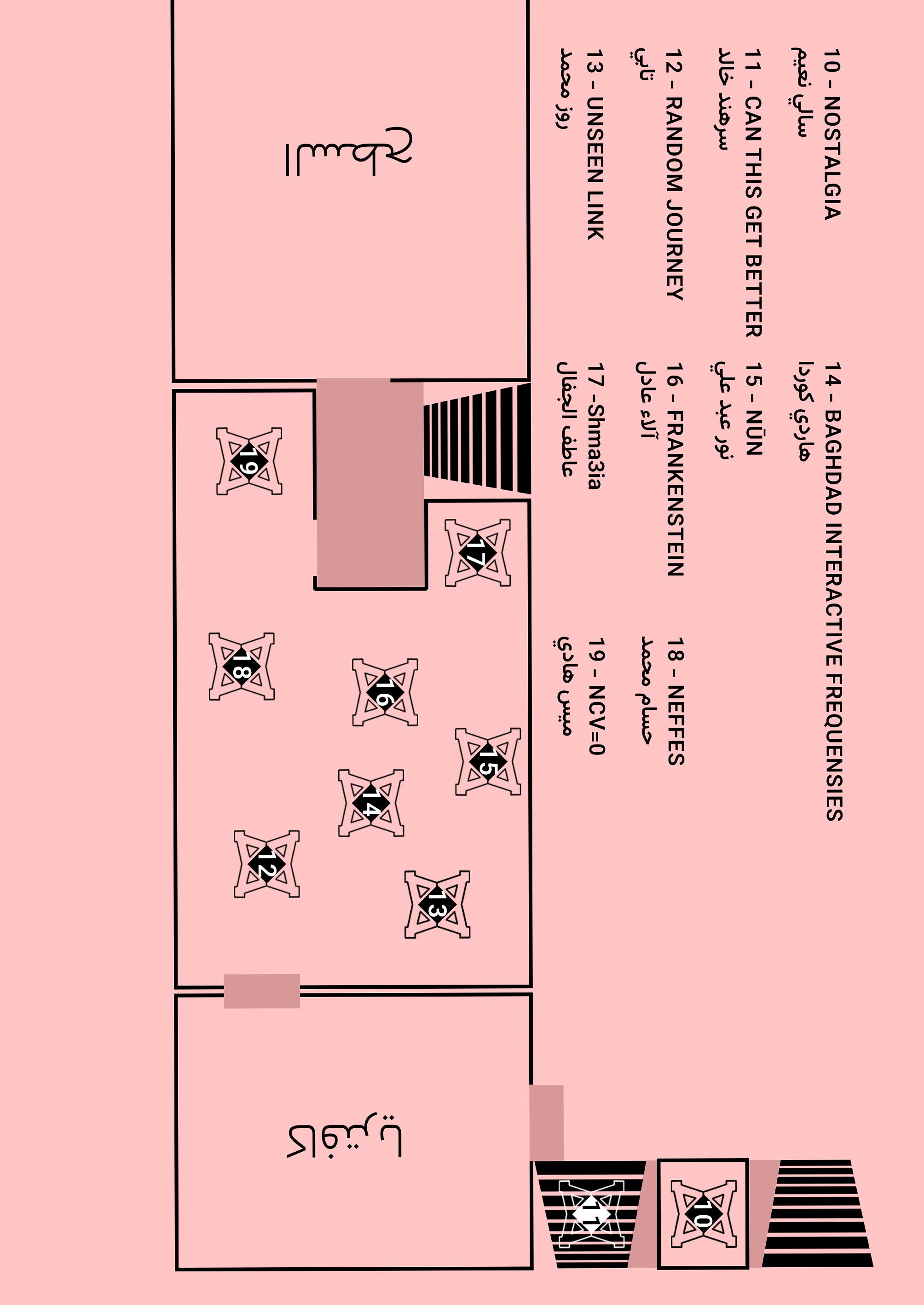

Tarkib Baghdad Contemporary Arts Festival
09.05. - 12.05.2024 in the Museum of Modern Arts (Gulbenkian Hall)
 Edited by Tarkib Organization for Arts & Culture
Edited by Tarkib Organization for Arts & Culture
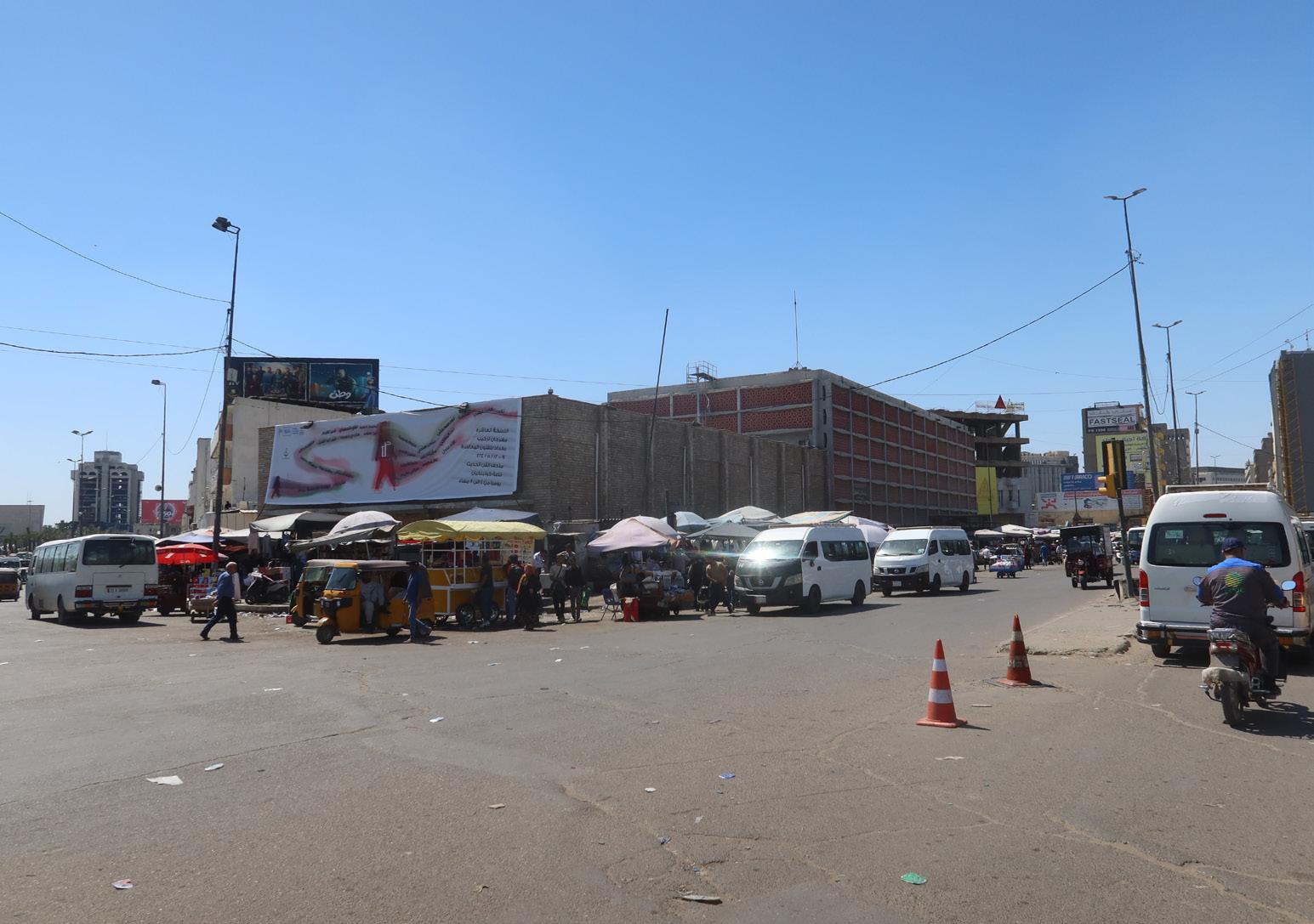
TARKIB - Baghdad Contemporary Arts Festival is Iraq’s only multi-disciplinary arts festival which takes place on four days every year, in order to connect the audience to the city’s contemporary art. In 2024, we celebrated the tenth edition of the festival in the Museum of Modern Arts (Gulbenkian Hall).
Acting in a historical place in the heart of Baghdad, this year’s edition provided conceptual zones by 19 emerging Iraqi artists using the entire venue. Conceptual art emphasizes the idea over traditional aesthetic and material concerns. The 19 zones, which included the exploration of culture of remembrance, community matters, identity, social media efects, human rights and climate issues in Iraq, are love letters to critical thinking. Presented works refect thoughts and feelings of Iraqi contemporary artists in an attempt to visualize the diferent aspects of our time. Most of the works in this edition show the interplay of text and visual.
One of the festival’s aims is to bring new life to places and to put a spotlight on cultural heritage, hence Iraqi identity. Opened in 1962 as the Modern Art Centre in Baghdad, but commonly known as Gulbenkian Hall, the museum is an ideal place and space to connect Iraqi modern art history with contemporary arts practices.
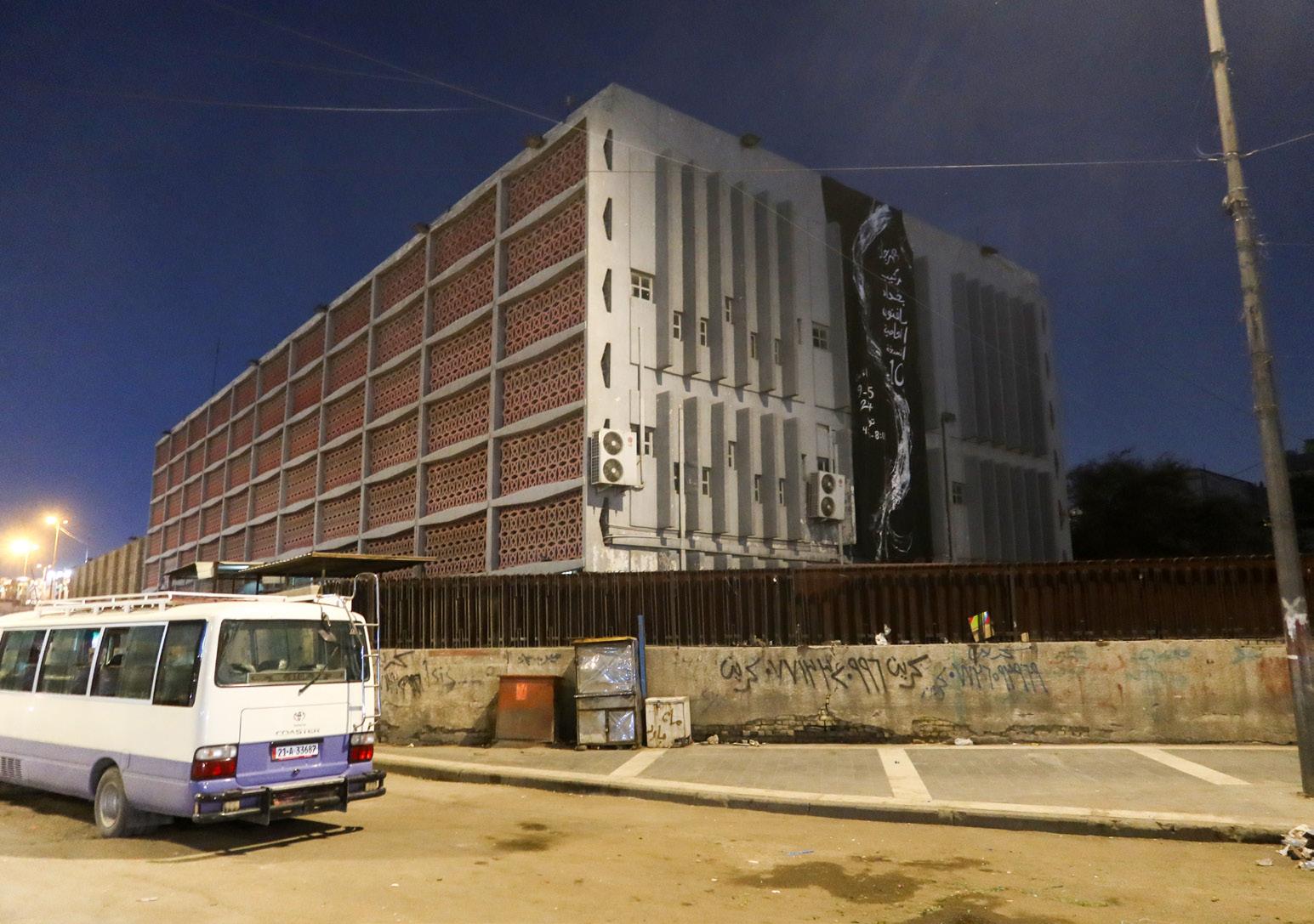
photo with the festival banner on the west-side of the museum
Both, Gulbenkian Hall and Tarkib represent the Zeitgeist of the time. Gulbenkian Hall since the end of the 1950s as part of the grassroots of Iraqi modern art and Tarkib during the last ten years, as part of the grassroots of Iraqi contemporary art.
“The tenth edition of the festival by Tarkib would like to take us on a new road: a road with heart and mind. Art means sensuousness. Art means knowledge. Art means scrutinizing. Art means questioning. Art means overcoming borders. But, also confrontation with other views, opinions, images. Art opens the mind and sometimes the heart. This is what I wish us all for this festival.” Hella Mewis
Exhibiting Artists:
Muhaned Taha | Haneen Hadiy | Noor Al Waily| Ali Ziyad| Amir Akram | Loay Al Hadhary | Zaid Saad | Hajer Qusay| Sally Naeem | Sarhand Khaled | Tabi | Rooz Mohammed | Hardi Kurda | Alaa Adil | Noor Al Waily | Hussam Mohammed| Atef Al Jafal | Aisha Shabeeb | Maees Hadi


photo with the festival banner on the west-side of the museum

Impressions Jawad Saleem Hall
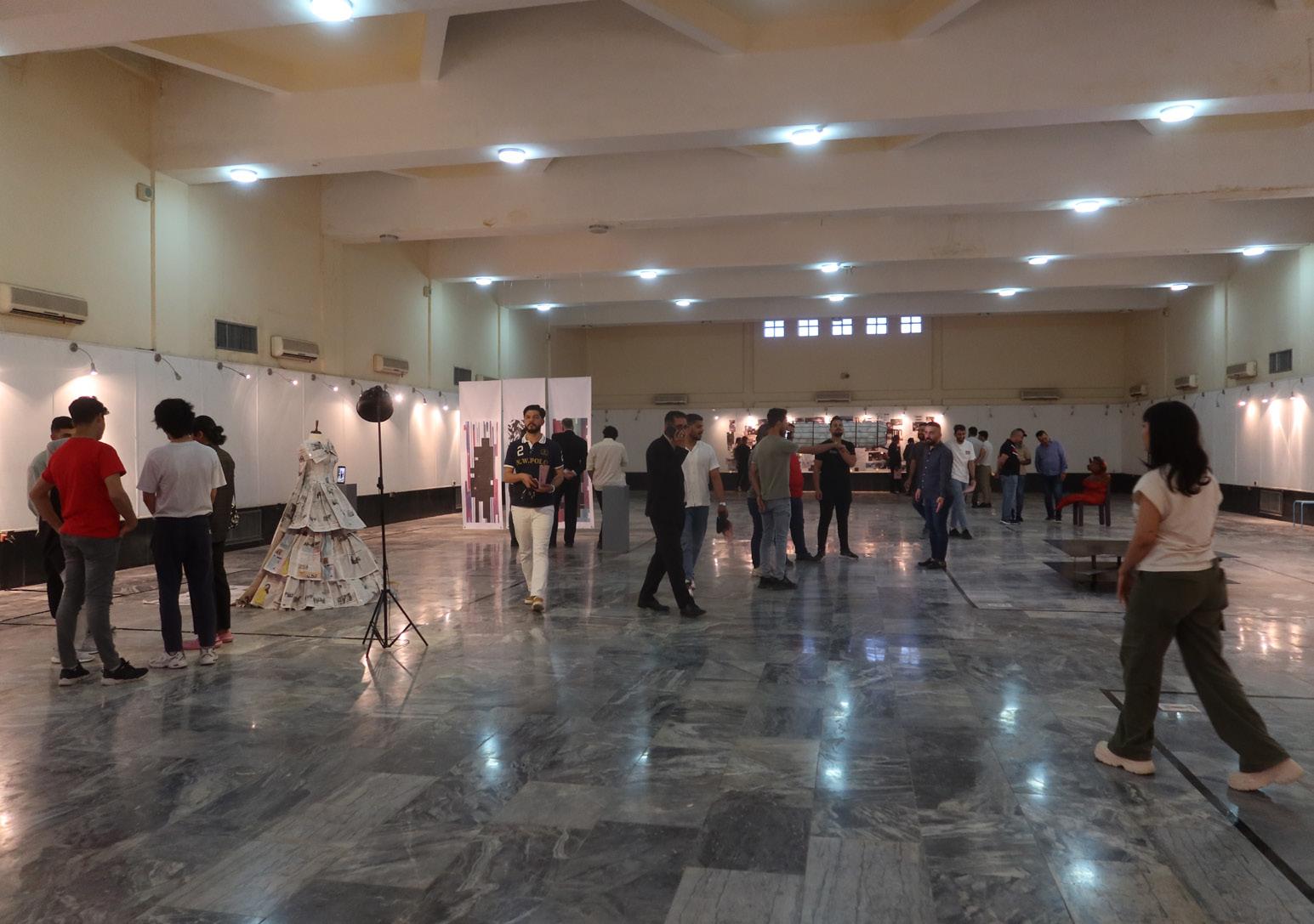

Impressions Atta Sabri Hall
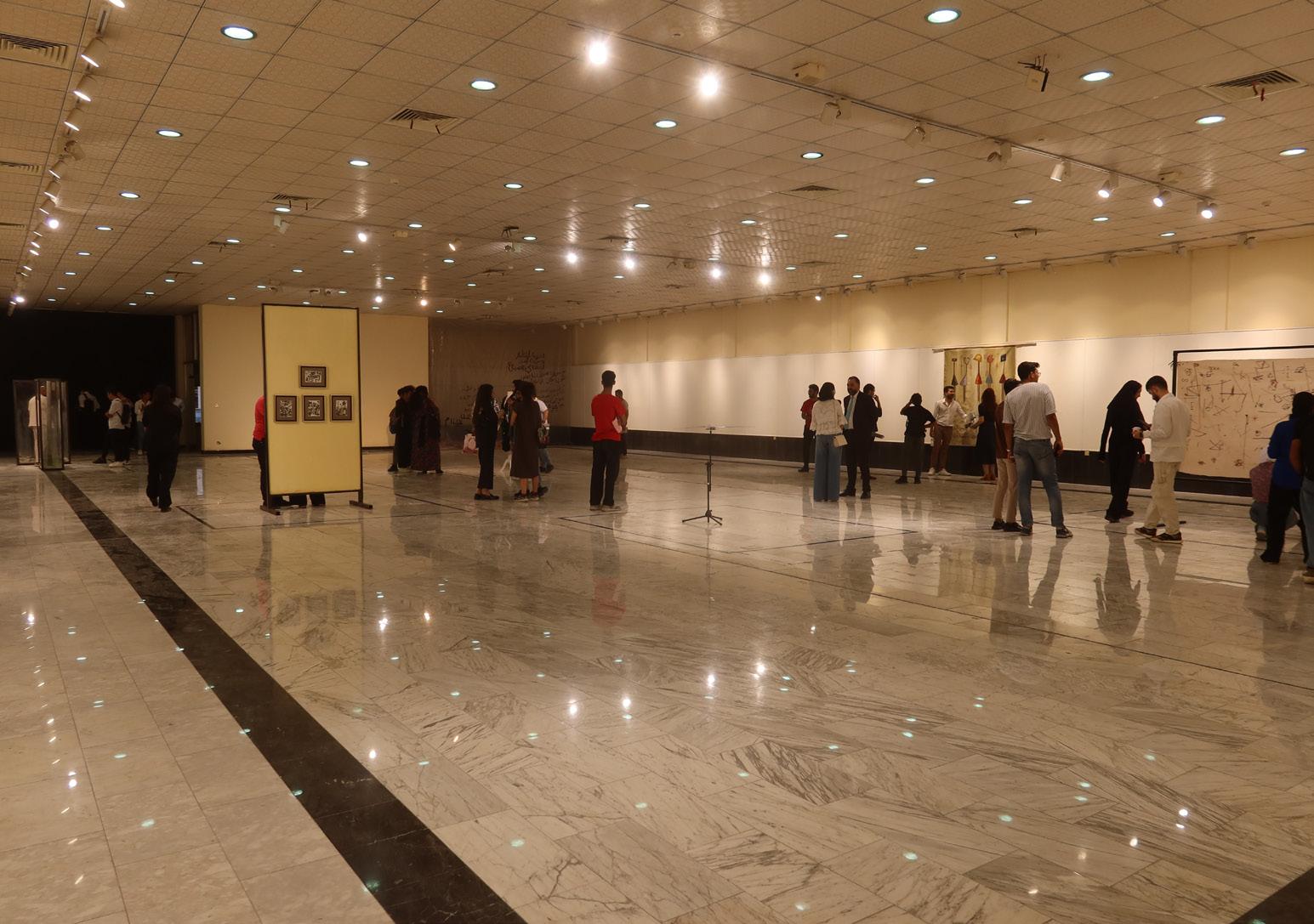

JARIDA TARKIB
Independent Art Newspaper
Published: 09.05.2024
Editor: Tarkib
On the occasion of the festival, Tarkib published a newspaper which gave historical background information about the venue where the festival was held. The newspaper included articles about Calouste Gulbenkian, also known as Mr. Five Percent, the work of the Portuguese Gulbenkian Foundation in Iraq from 1957 to 1972 and the history and its architectural features of the Museum of Modern Art (Gulbenkian Hall).
 Photos: Gulbenkian Archives
Photos: Gulbenkian Archives
1_AL MURSHIDA
Muhaned Taha
Muhaned Taha’s four-meter-high textile installation sculpture is based on a poem by Muafaq Mohammed published in 2018. The poem, which was written on black fabric surrounding a column, refers to a conversation between martyrs about the feelings of loss of the bereaved. The emergence of the martyr cult in Iraq dates back to 1942, but Muhaned Taha refers to the martyrdom of the past twenty years. The 2003 invasion of Iraq turned frst into a military occupation of Iraq by the United States and its allies. The invasion resulted second in a troubled and increasingly insecure country for two decades. He wants to honour the families who lost someone due to countless diferent acts of violence happened all over Iraq in the last twenty years.
Muhaned Taha got inspired for his installation by the heroic end verse of the aforementioned poem ‘like hills of black abayas, she fies crying to the sky’. Therefore, his big-size sculpture has the shape of a mountain of abayas. He chose a specifc kind of abaya, traditionally worn by Iraqi women, at least in the past, which is the bridge to the title. Al Murshida is the experienced female veteran of advising family refers. For Muhaned Taha both, the traditional abaya and Al Murshida, seem to fall into oblivion in modern days. His sculpture is a reference to the appreciative status that women should have in Iraqi society.

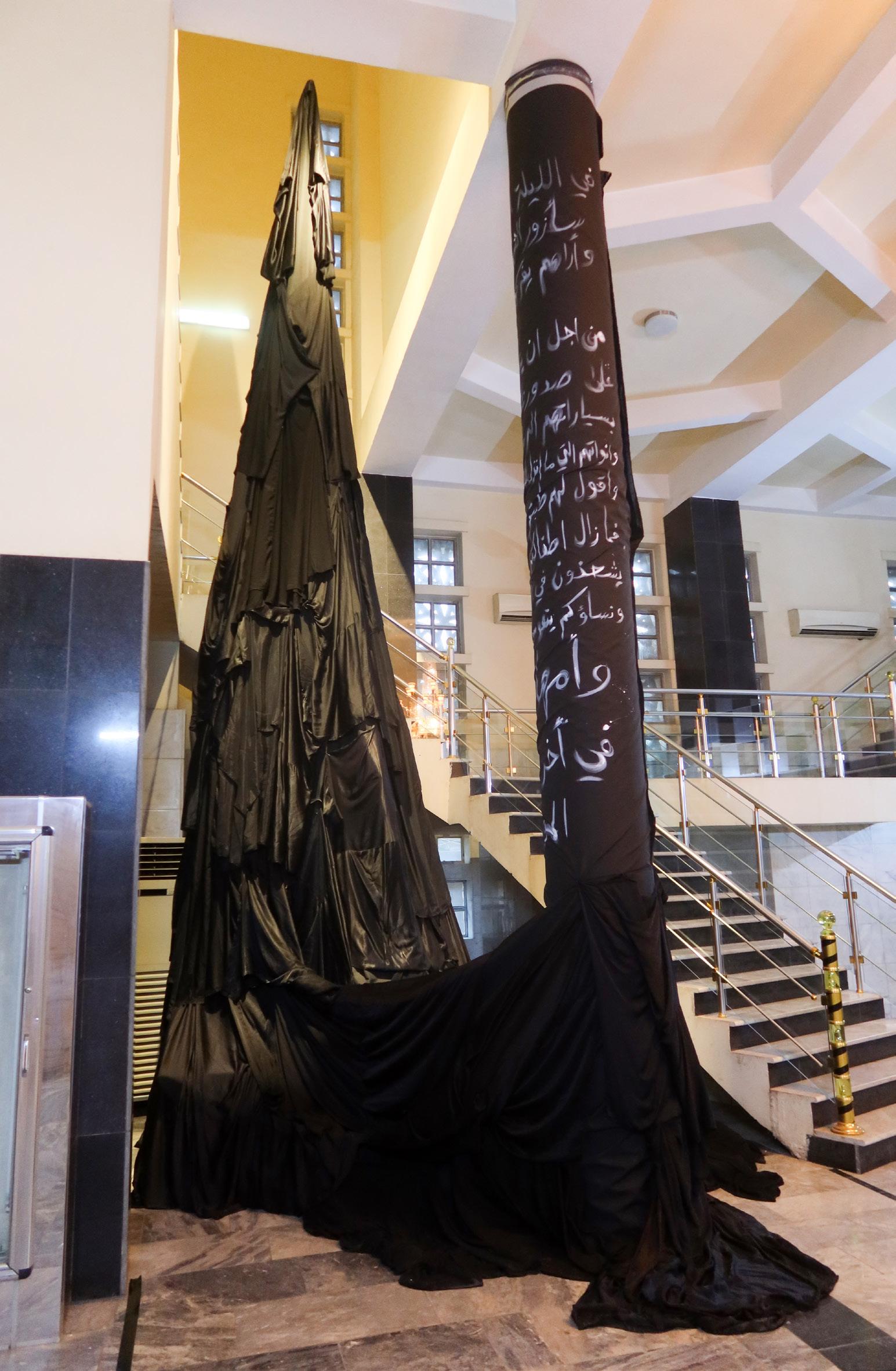








2_REPETITION
Haneen HadiyHaneen Hadiy’s textile work explores the multifaceted nature of repetition in textual form, unraveling its signifcance, symbolism, and impact on both the artist and the viewer. From subtle echoes to bold statements, these works ofer a profound refection on the power of language and its endless possibilities when iterated. As viewers navigate through the immersive environment, they became immersed in a rhythmic dialogue that challenges perception of time, space, and meaning.
Her textiles ofer a captivating journey into the realm of repeated text in contemporary art by inviting viewers to explore the endless echoes of meaning, memory, and metaphor that reverberate throughout each work. The repeated words are based on her own research in Iraqi history and identity such as ‘cradle of civilization’ inside and outside the map of Iraq or the word ‘Iraqi’ on the biggest textile or the names of the rivers Furat (Euphrates) and Dijla (Tigris) on the small square formats. Haneen Hadiy used the repetition in art to build a sense of tension which is the key to the understanding of her pieces and Iraqi identity.












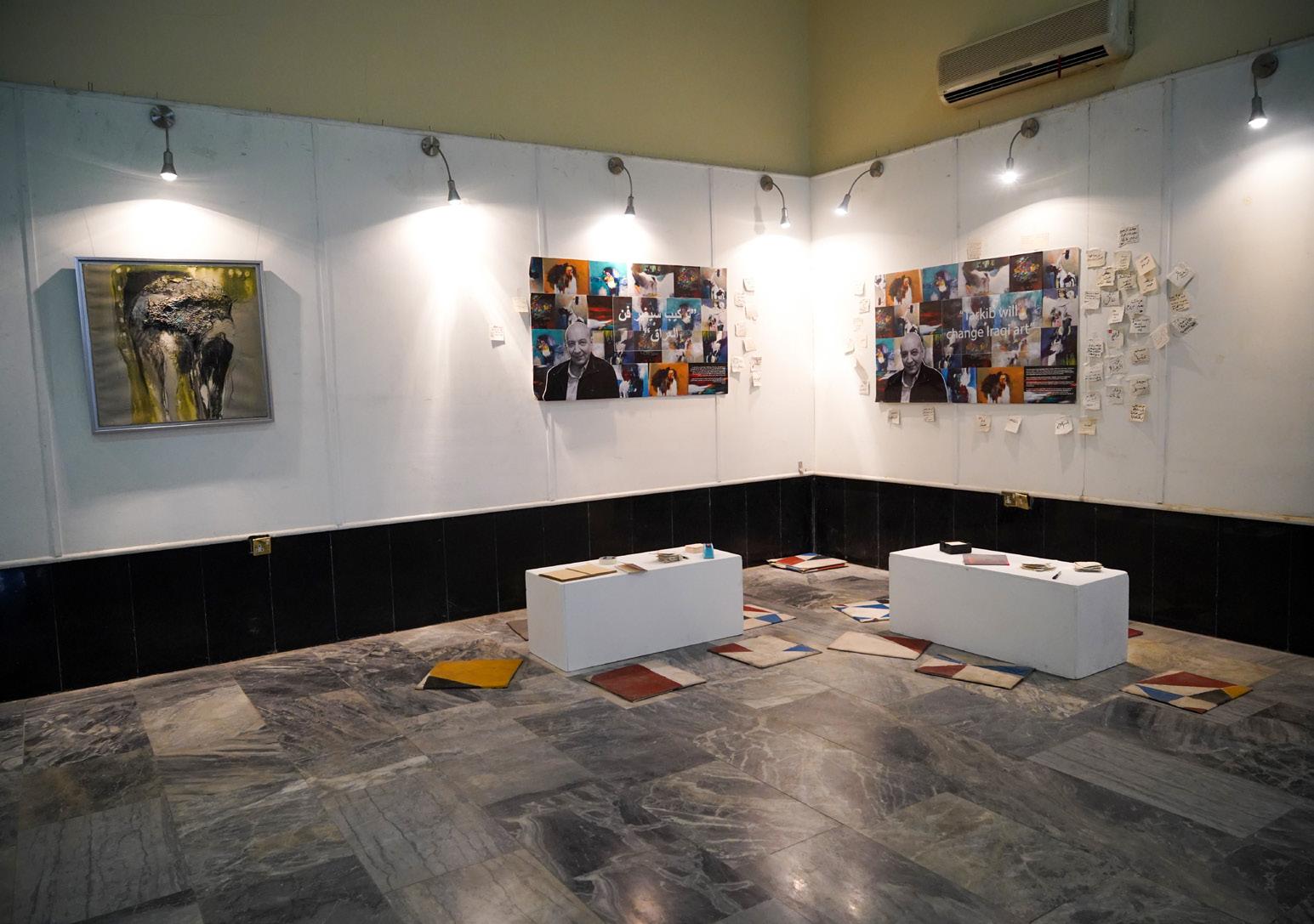
3_BALASIM
Tarkib
The artist, art historian and art professor Dr. Balasim Mohammed was a supporter of Tarkib from its very beginning back in 2015, when everybody else pointed on us: ‘This is not art’. After he passed away in 2021, we decided to dedicate the festival to him, because the festival was the starting point of Tarkib witnessed and supported by Balasim.
Balasim witnessed and shaped the Zeitgeist of at least fve intellectual, moral, and cultural climates of an era in Iraq. One era, his last one, we were able to share with him.
The memory corner in Jawad Saleem Hall showed a collage with his paintings, photographed by Betoul Mahdiy, a message from his daughter Sara and a quote from an interview he gave in 2016: “Tarkib will change Iraqi art”.
Balasim was a smoker and his preferred brand was “de Merrier”. Visitors were invited to write down memories with Balasim or messages to him on vat paper notes which were made out of de Merrier cigarette packets.



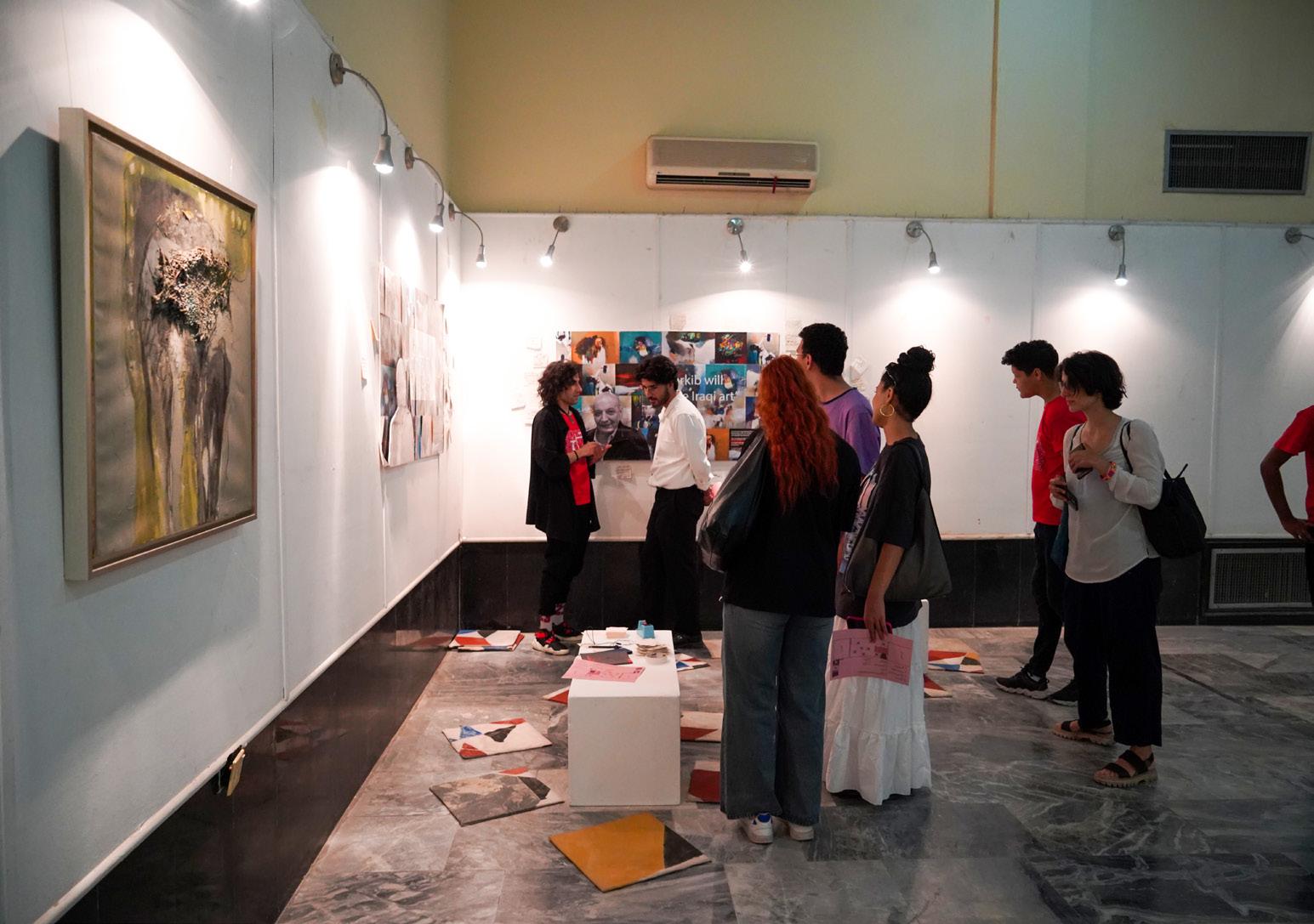


4_JARIDA
Noor Al Waily
The paintress Noor Al Waily presented a female fgure wrapped in a phantasmagoric wedding dress with a train made out of folded newspapers. The work is questioning the racing rate of divorces in Iraq, the most in Iraq’s history, which researchers link to changed economic and social conditions under a still dominating patriarchal system that lacks protecting women and children.
Noor Al Waily is questioning in her work the ways of decision making for a possible marriage, the accompanying and guided interferences by others before and after which as a consequence often lead to separation. These surrounding interventions in a family concept is expressed through folding papers.
She is especially concerned about the children left behind a divorce. By using newspapers, she wanted to show: “that words and pictures are nothing but a cause of the destruction of a family.” The aim of a newspaper is to deliver information by text and images. Her misuse of a newspaper is an expression, how words and images can infuence an intended healthy family concept.
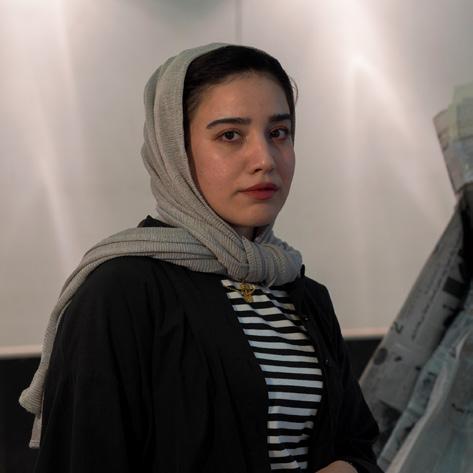








5_TECTONIC SQUARE
Ali ZiyadThe iron square-shaped sculpture by the architectural student Ali Ziyad investigates the development of executed architecture in Iraq. His sculpture is composed of three layers. The foating base mirrors the heritage sites before the founding of the modern state of Iraq in 1921. The second layer appears for the so called ‘Golden Age’ in Iraqi architecture within the period of the 1940s to 1990s. He chose the shape of a square because of its stable form which represent for him a system. The system with two layers holds the third representing the chaos in urban fabric we are currently live in with random buildings and putting prestige projects before the needs of the people.
The two surface peeled of from the square represent architect and society as two sides of the same coin, where common things connect them, such as culture, history, and the environment, highlighting the intertwined relationship between society and architecture. The actual mission of architecture is to improve people’s lives. The reality of architecture and urban fabric applied in Iraq needs a lot of development and improvement to suit the nature of society and its life.





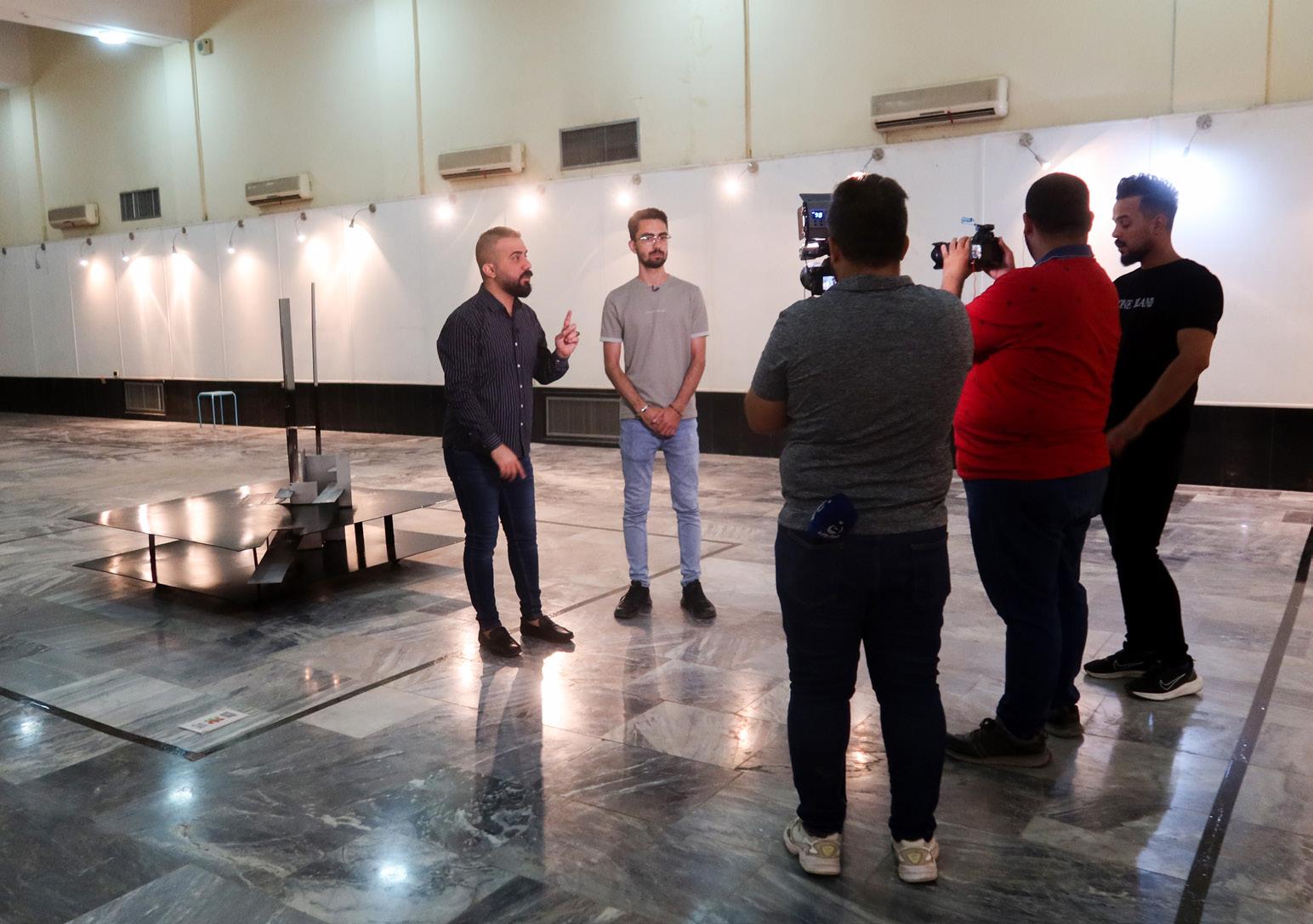

6_PHANTOM PRESENCE
Amir Akram
Phantom Presence was a mixed-reality AR art installation. The architect Amir Akram is using Augmented Reality (AR) to invite visitors to delve into the ambiguity of the incomprehensible that shapes life. Visitors could dialogue with his phantoms, which are not only interactive portrayals, but representing the depth of thought and imagination the events of life may trigger.
“A transparent layer of AR reveals ethereal forms with ghostly apparitions that come and go right on the edge between physical attributes and reminiscence. The participant can dialogue with these phantasmal creatures, chronicle not only the interactive portrayals but also the depth of thought and imagination the events may trigger. Living in the out-of-sight world, they are allowed to ponder over the impermanence of life and the powerful, unforeseen forces that ultimately mold the world. PHANTOM PRESENCE gives a stunning as well as lyrical vessel of interpretation despite the vagueness in spirits, inviting viewers to dip down into the moat of ambiguity which ways them forward their understanding of the incomprehensible.” Amir Akram
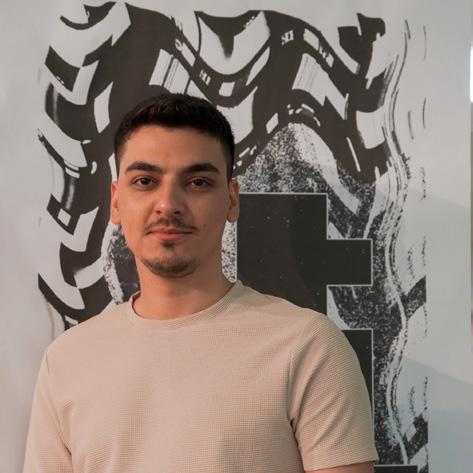










7_FASHIONISTA
Loay Al Hadhary“Social networking sites have provided some trivial people with an opportunity to appear, spread and emerge from their holes. Therefore, the average citizen has become forced and surrounded by this tide of bad content. The star today in social media is not the thinker, the intellectual, or the artist, but rather the trivial.”
Fashionista is a false used term by young Iraqi who became ‘trending’ on social media. Gender does not matter. Loay Al Hadhary’s female fgure bears the head of a bufalo, a reminder to the bufalo cow Smera who became recently suddenly famous on social media. His bufalo has a face shape of a pig, because a pig has no honour. The horns are made out of pigtails, which he typically uses in his fgurative sculptures. The female fgure does not have legs, because the so-called fashionistas usually present themselves in social media only showing their upper part of the body.
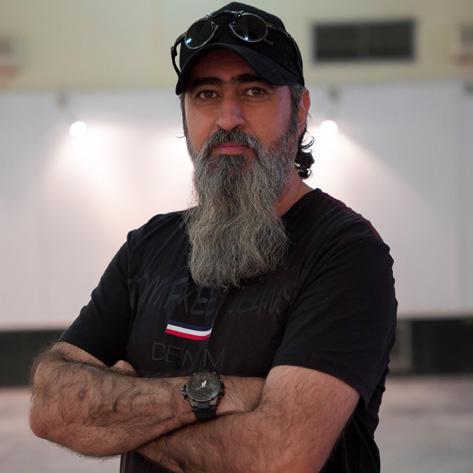


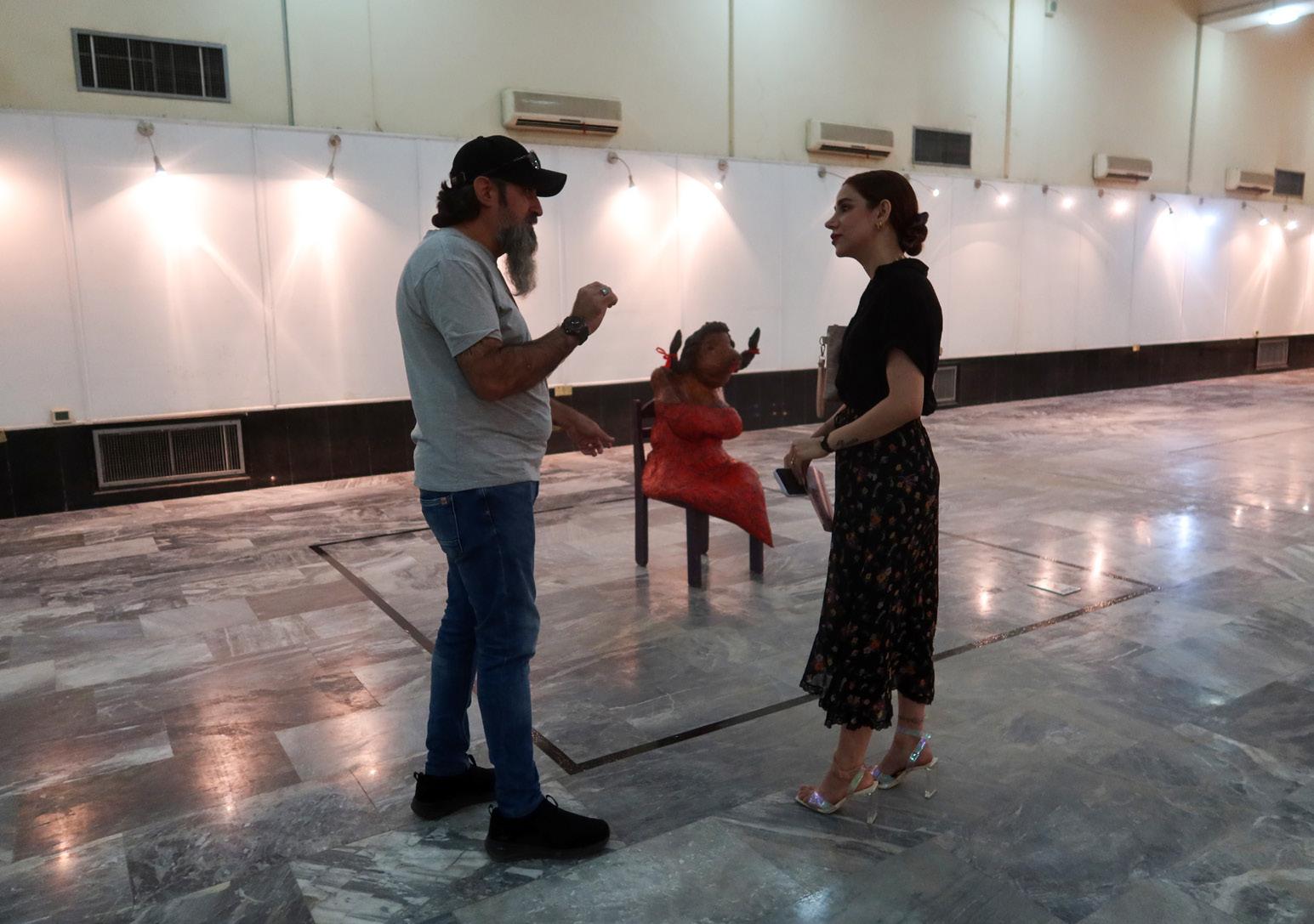



8_CATCHY
Zaid SaadZaid Saad’s conceptual work is a combination of a hanging sculpture and a research wallpaper examining the cluster bomb CBU-87 Combined Efects Munition. CBU stands for Cluster Bomb Unit and consists of a canister, a fuze and 202 bomblets. The type of bomb was used in Iraq by the United States Air Forces in 1991 and in 2003. They have a wider area of efect, and they consistently leave behind a large number of unexploded bomblets ready to detonate on contact. These bomblets have a ‘catchy’ shape attracting kids to play with it. According to his research 94% of cluster bomb casualties are civilians and 40% are children.
His sculpture embodies a real size CBU-87 made out of iron bars usually used in construction to symbolize the impact of the bomblets to destroy buildings. Zaid Saad replaced the 202 ticking time bombs with white balloons to underline the aggravated impact on civilian’s and especially children’s lives.
His accompanying wall newspaper showcased his comprehensive research giving detailed background information and statistics about these cluster munitions. His research included names of factories and countries that manufacture cluster munitions, sales deals between countries, status of the convention on cluster munitions, a timeline of its usage from 1943 to the present, the number of victims throughout the history, a pictorial explanation of the method of its use and its impact on infrastructure and civilians and a detailed explanation of the American made model CBU-87, which was used in Iraq.













9_REACTIVATE REALITY
Hajer QusayREACTIVATE REALITY is a video installation and a live performance by the flmmaker Hajer Qusay criticizing the infuence of social media and new technology on people’s perception of reality. She was questioning how social media controls people, changes thoughts and way of thinking, ways to know ourselves and how we present ourselves to other people. She asked: “Are we controlled by program algorithm?”.
Her video included all elements which represents programming, hacking and other computer-generated functions such as negative introvert images paired with pop-art colours used in social media. She presented herself in the video using mimic and gestures connected to the way social media is used and absorbed.
Her live performance showed her body shadow performing within a cube representing how people are locked in the social media bulb. With the form of a cube she wanted to show that there seems to be no window to go out of the box.

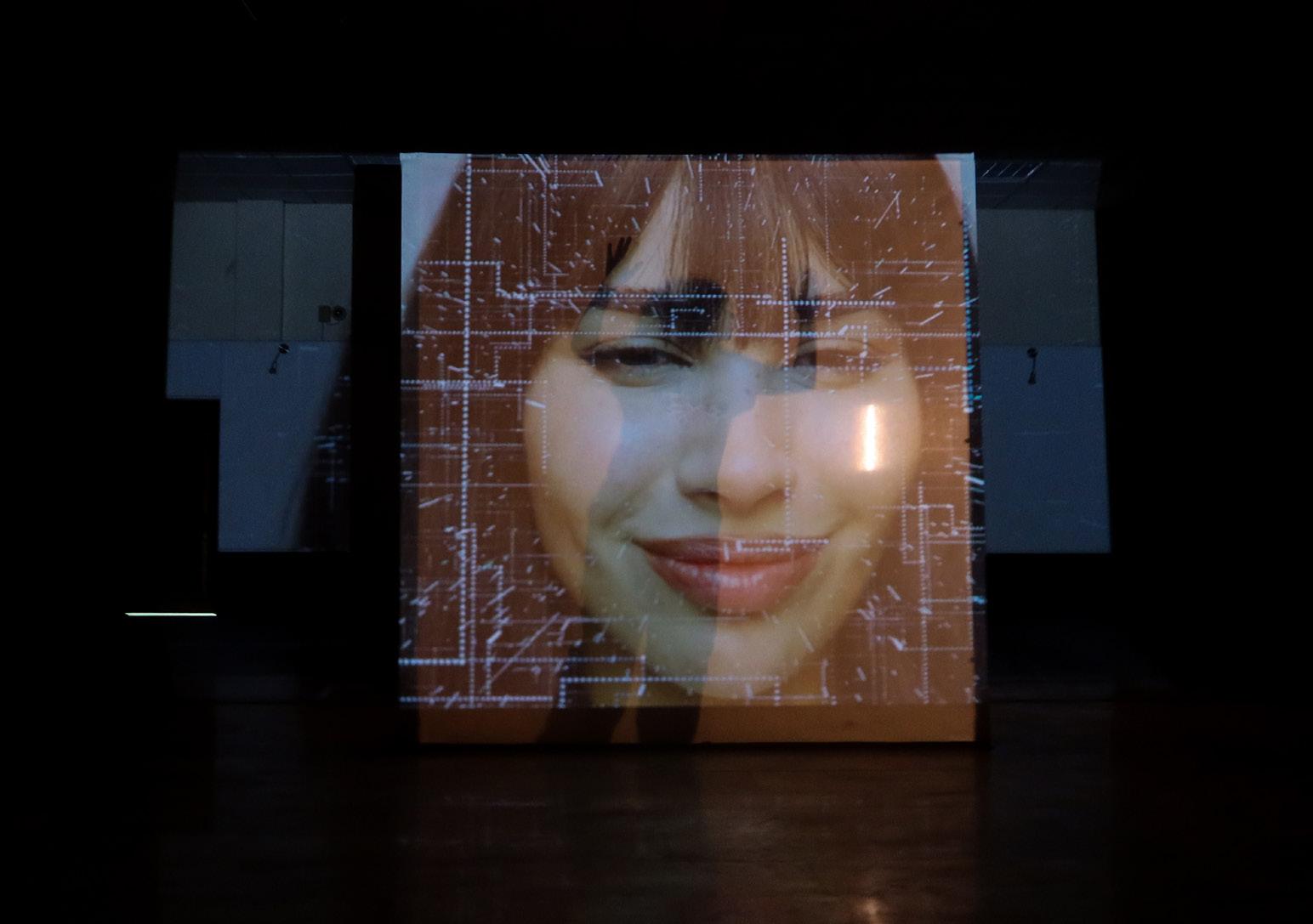
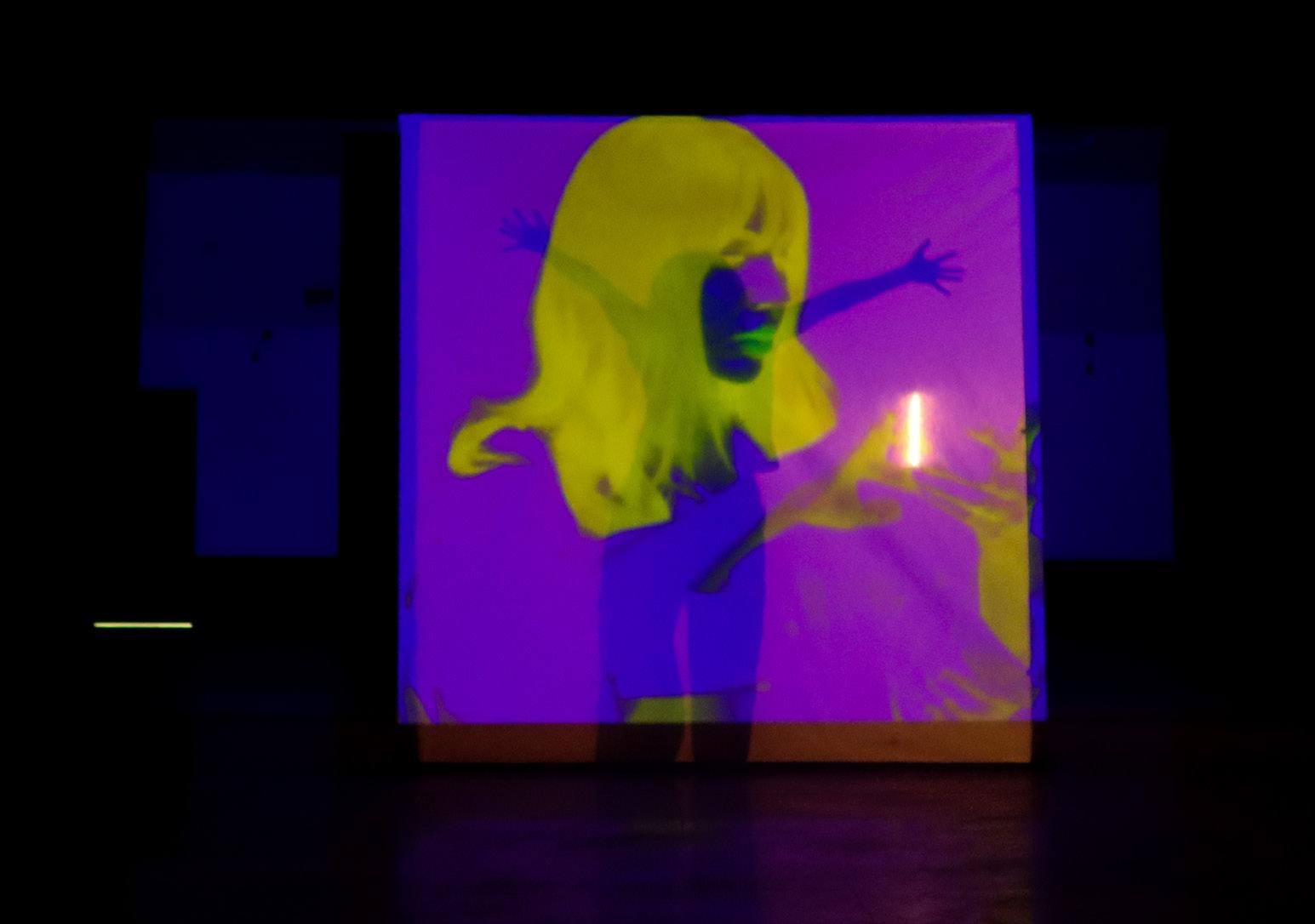







10_NOSTALGIA
Sally Naeem
Music by Hassan Al Narjas
NOSTALGIA was a video installation by the architectural student Sally Naeem inviting visitors to refect inspiring moments of our childhood memories as a basis and essence of someone’s and the community’s identity. Visitors were frst invited to see her 3D modeled posters refecting changing lights on a window, a door, a stair and a swing accompanied by a meditating music composed by Hassan Al Narjes. Afterwards she asked the audience to write or sketch childhood memories on handmade paper.
“Memories mean a lot to me, especially childhood memories. Because every time I forget myself and life’s burdens overwhelm me, I go back to my memories and remember love, security, and the foundation that exists within me. I remind myself of who Sally is. Memories resonate with everyone, but not everyone is willing to revisit their childhood memories to draw hope or learning from them. One should not be saddened because they have ended, but remember that they are part of you, and they exist within you in all those versions.”


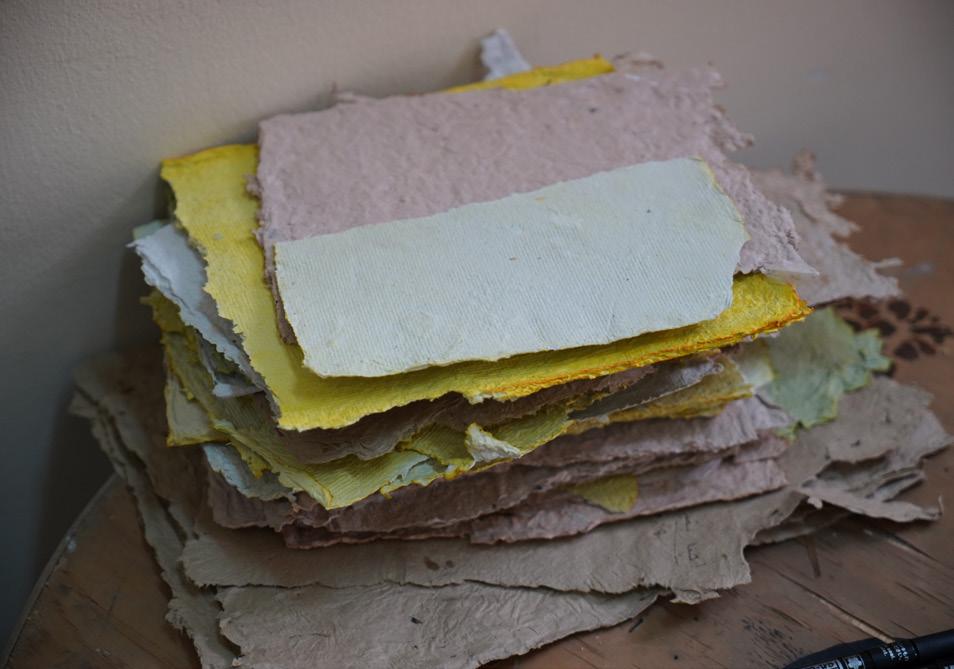



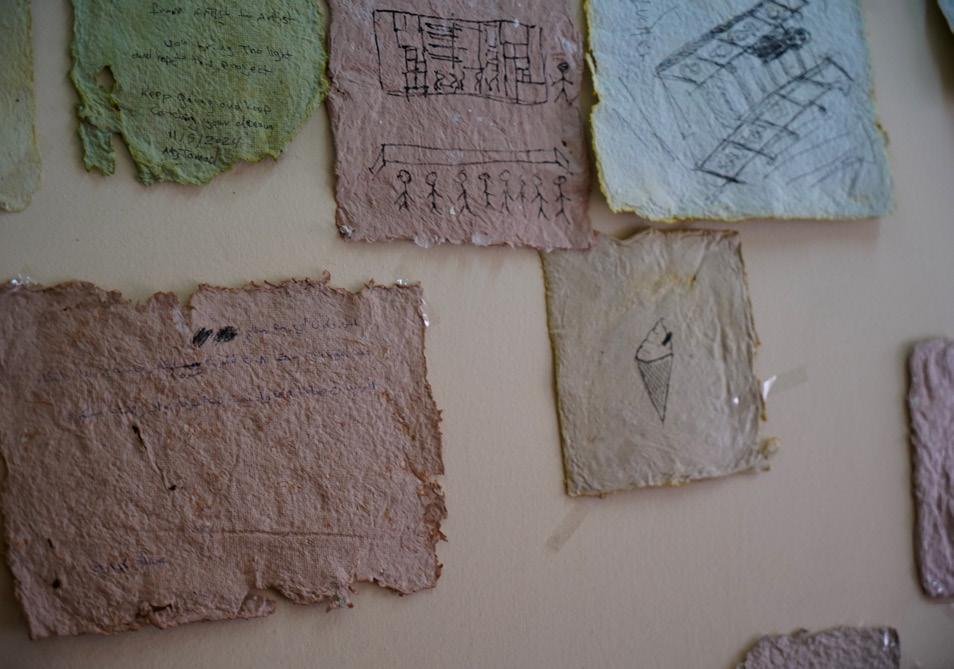


11_CAN THIS GET BETTER?
Sarhand Khaled
The architect Sarhand Khaled from Suleymaniya is concerned about architecture and its implementation in Iraq which efects people’s life and well-being. Last year he founded his architect studio White Studio Iraq and started his campaign “Can This Get Better?”. The campaign is a call for change, a call to ask questions about our built environment concerning sustainability, heritage and restauration, walkability, visual pollution, aesthetics and social interaction.


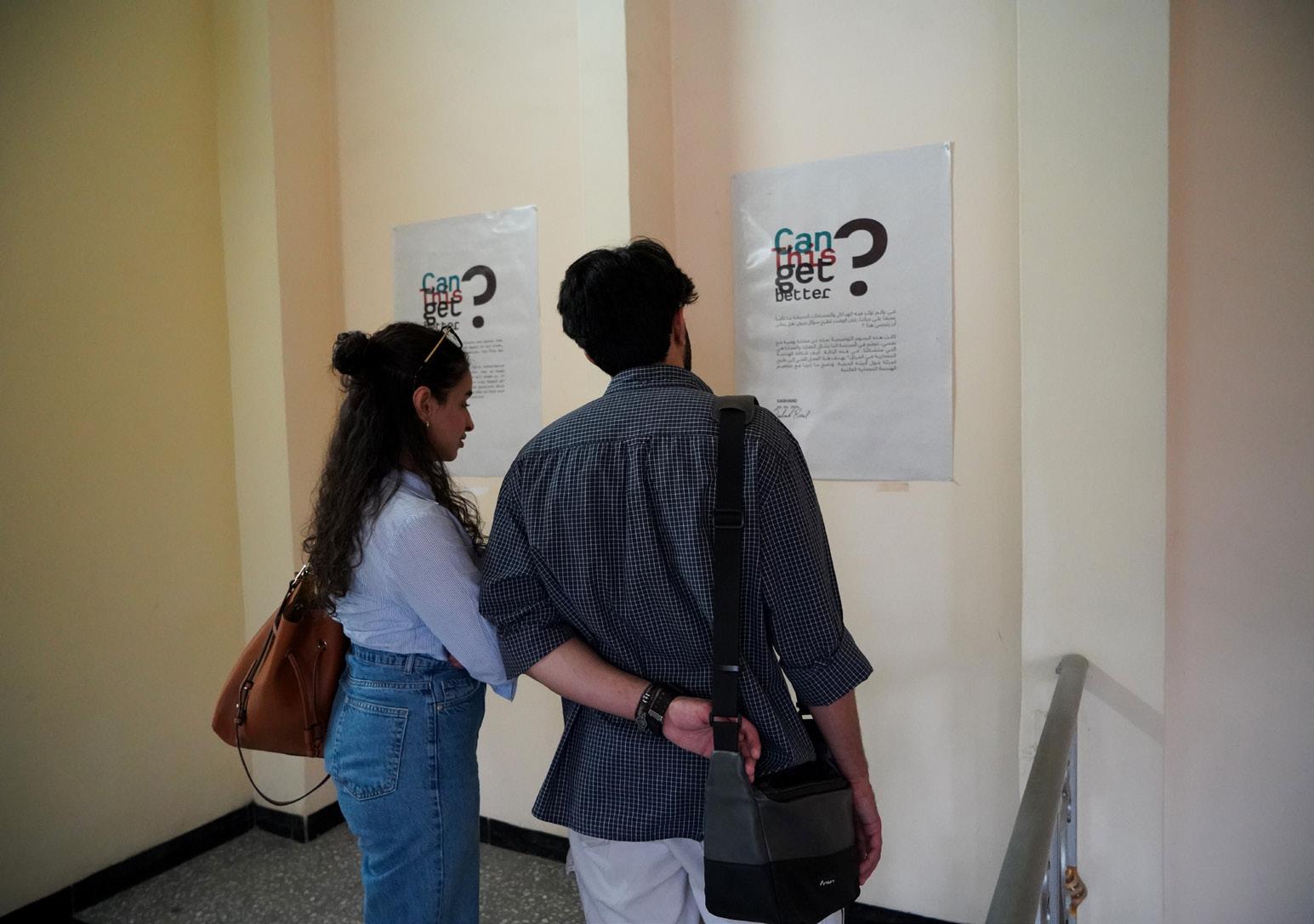






12_RANDOM JOURNEY
Tabi
Tabi’s work is a text art where she combined her typical fgures with a poem she wrote by using Artifcial Intelligence (AI). She investigates people’s journey of search and discovery, the maze of time and place in the randomness of a life journey. Tabi is constantly experimenting with technics within her characteristic style consisting of the fgure of Magrood, wires and points. For RANDOM JOURNEY, she got inspired by the style of the early work of Dia Al Azawi. To use black and gold inch on paper was a random result of a test of inch pens that she liked.



In the maze of time and place we wander,
Souls intertwined in the whirlpool of fate,
In the randomness of life, we live and contemplate,
And write the story of the self in the chapters of oblivion.
In this perplexing and dark space, We bend to accept the mystery and denial,
For all our decisions are threads in the fabric,
And all our movements a melody in eternity.
Freedom mixed with fear and questioning,
To be the sought-after of everyone’s dreams,
And in this interconnected existence we realize,
That we are all part of one being,
For we are all dreams and desires,
Searching for meaning in the seas of meaninglessness,
And in the journey of search and discovery, We meet ourselves in every face.










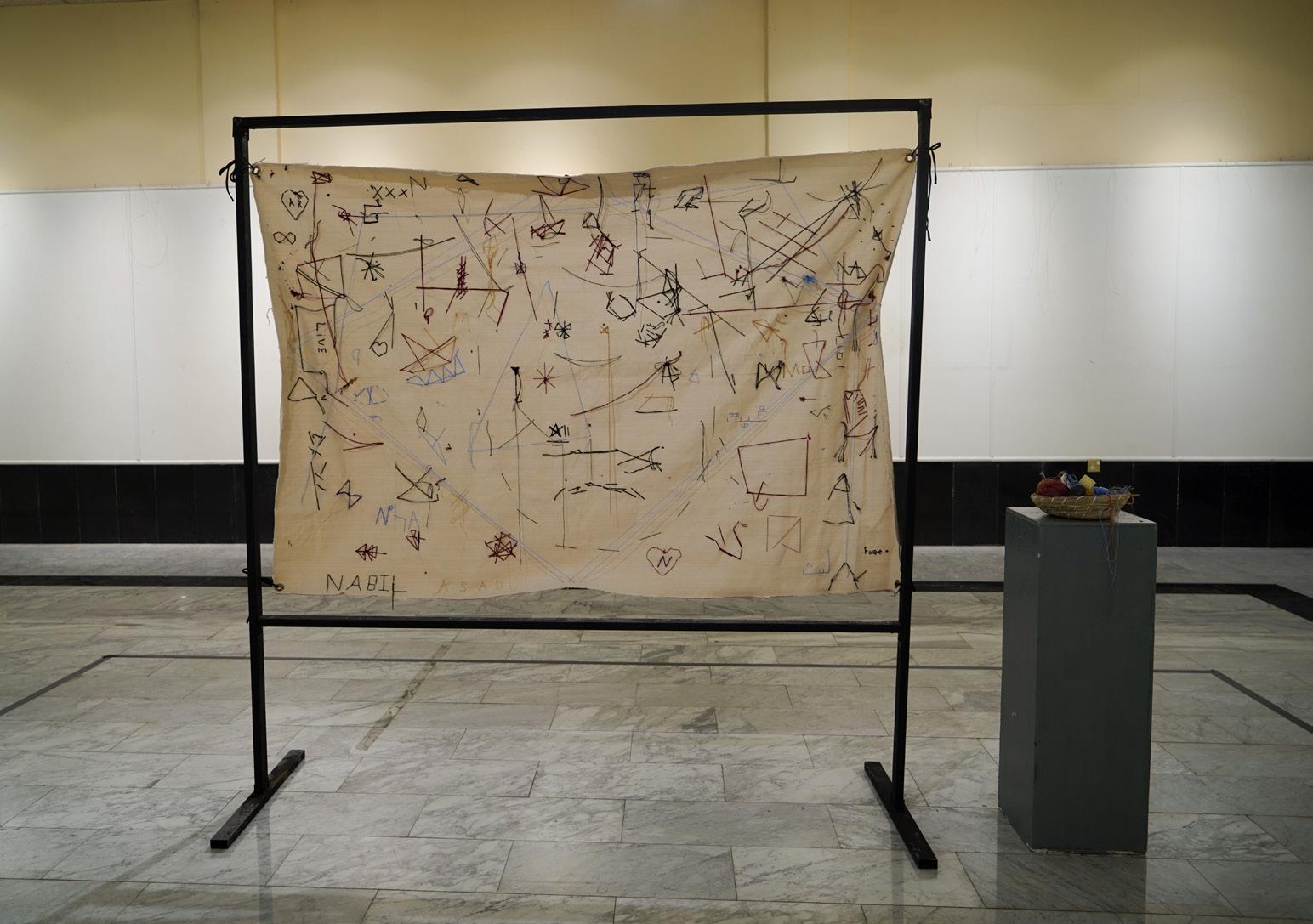
13_UNSEEN LINK
Rooz Mohammed
The textile work UNSEEN LINK was presented in 7.th Tarkib Baghdad Contemporary Art Festival in Al Zawraa Parc in 2021 as an audience-participatory artwork inviting visitors to link history by sewing together patterns without seeing each other. The work was chosen to be presented again to underline the timeless connection of sewing or building history.
“To progress through history, one must interact with somebody else. The person who passes the needle through the fabric, will need someone else to give the needle back. Together they will be drawing along the fabric of history. As for any action, there has to be a reaction. Even though the fabric is not completely transparent, one cannot make out who is exactly on the other side of the fabric. No one can completely understand the intention of those on the opposite side of history. But they need their presence so that they will pass together through history.” Rooz Mohammed
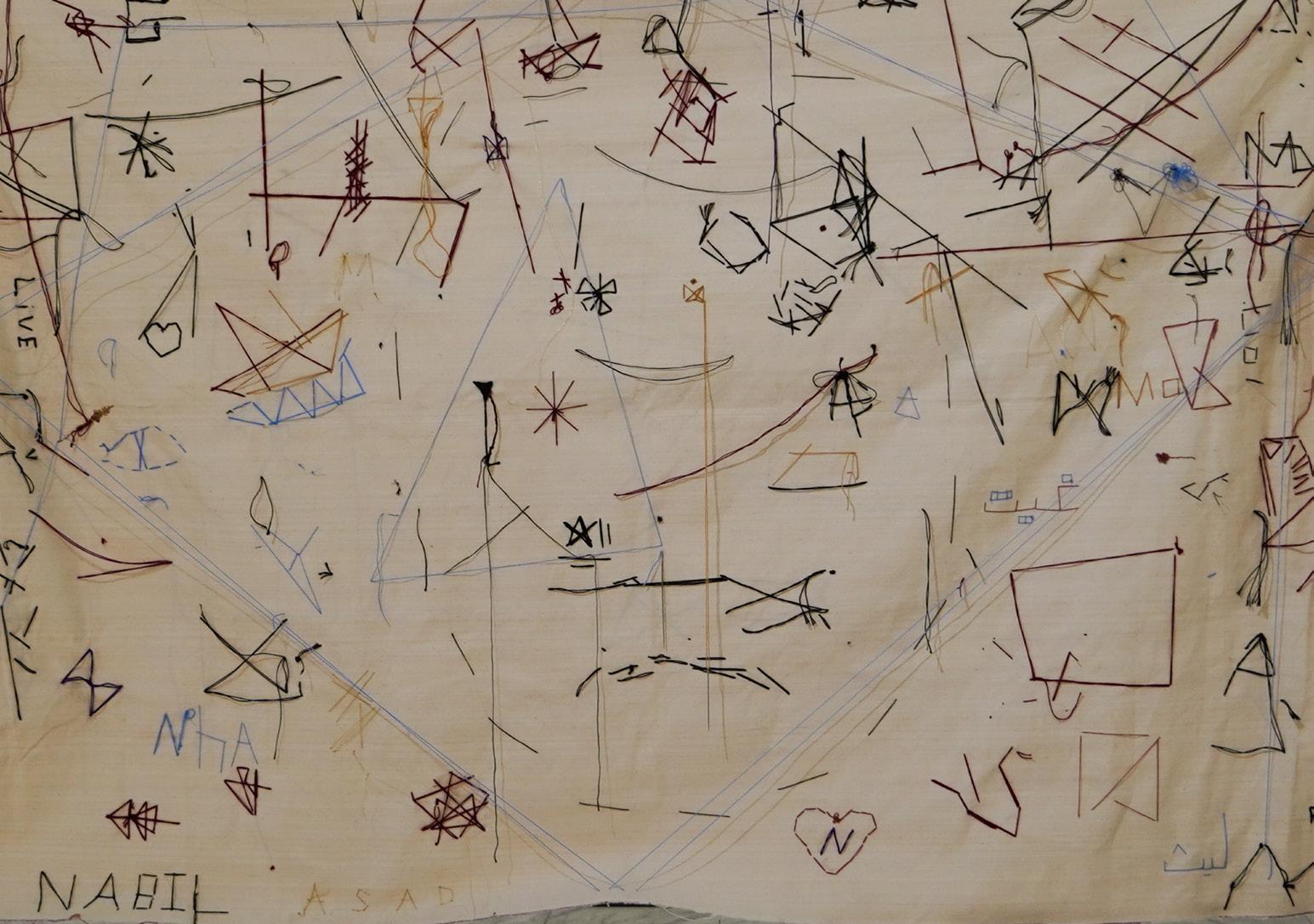


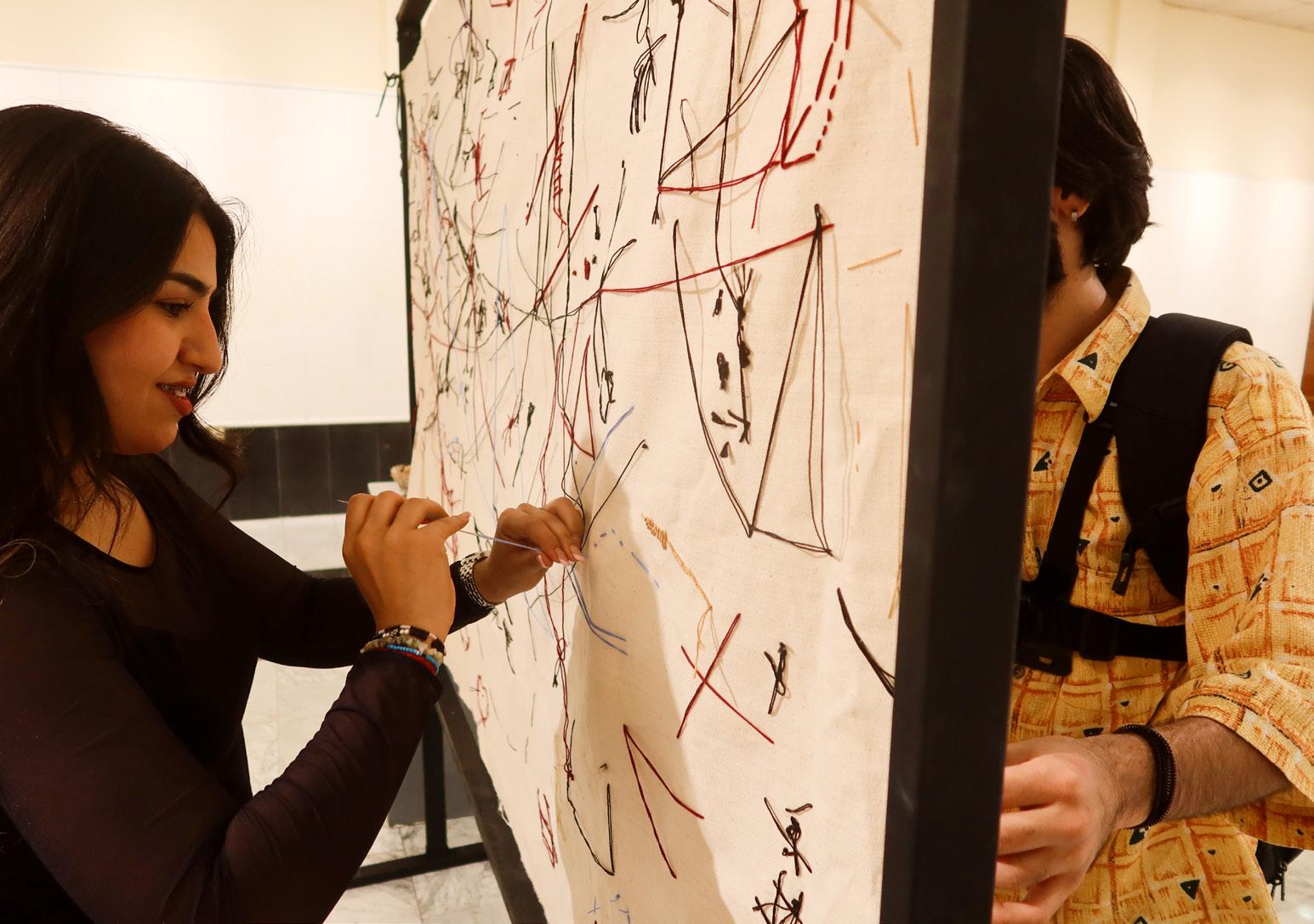


14_BAGHDAD INTERACTIVE FREQUENCIES
Hardi Kurda
The sound artist Hardi Kurda presented an audience-participatory installation inviting the audience to feel and interact with the frequencies he found underwater in the Tigris closed to Al Iraqia TV station when he visited Baghdad in September 2023.
“What does illegality mean, and how has the construction of legality shaped our lives? How do authorities legitimize an illegal activity, such as selling weapons? Hardi also legitimized an illegally manipulated radio circuit board.
The concept of the interactive illegal radio stems from Hardi’s unique listening experience when he immigrated illegally to Europe in 2002. Traveling inside a shipping container, he used a small radio to gather information about his surroundings. The radio’s noise provided a unique form of knowledge, akin to what Olivero called ‘survival listening.’ In this state, it was crucial to communicate with other senses: taste, smell, vibration, temperature, and touch. Listening became a tool and a new form of awareness for body movement in a confned space.”
Hardi Kurda
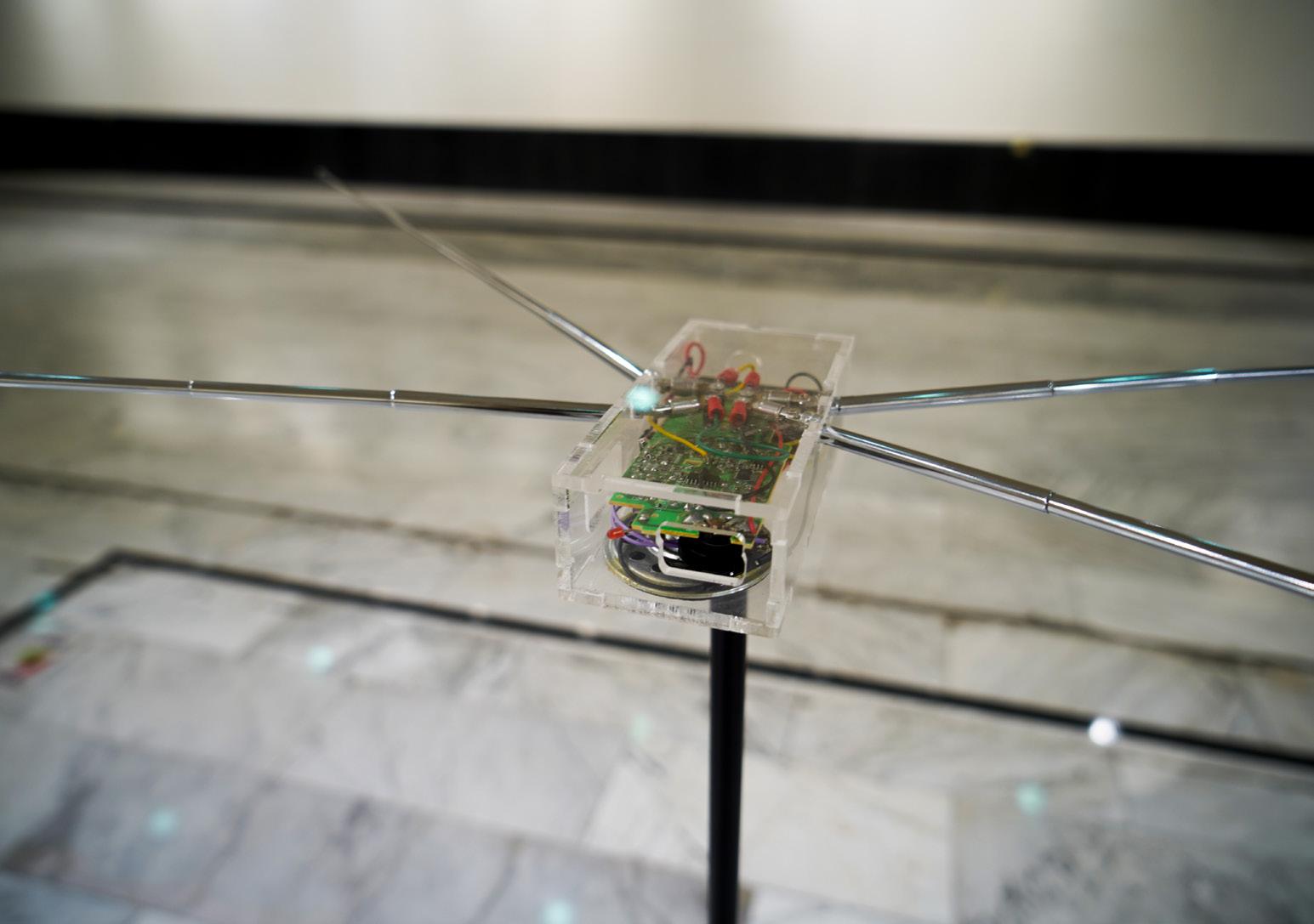
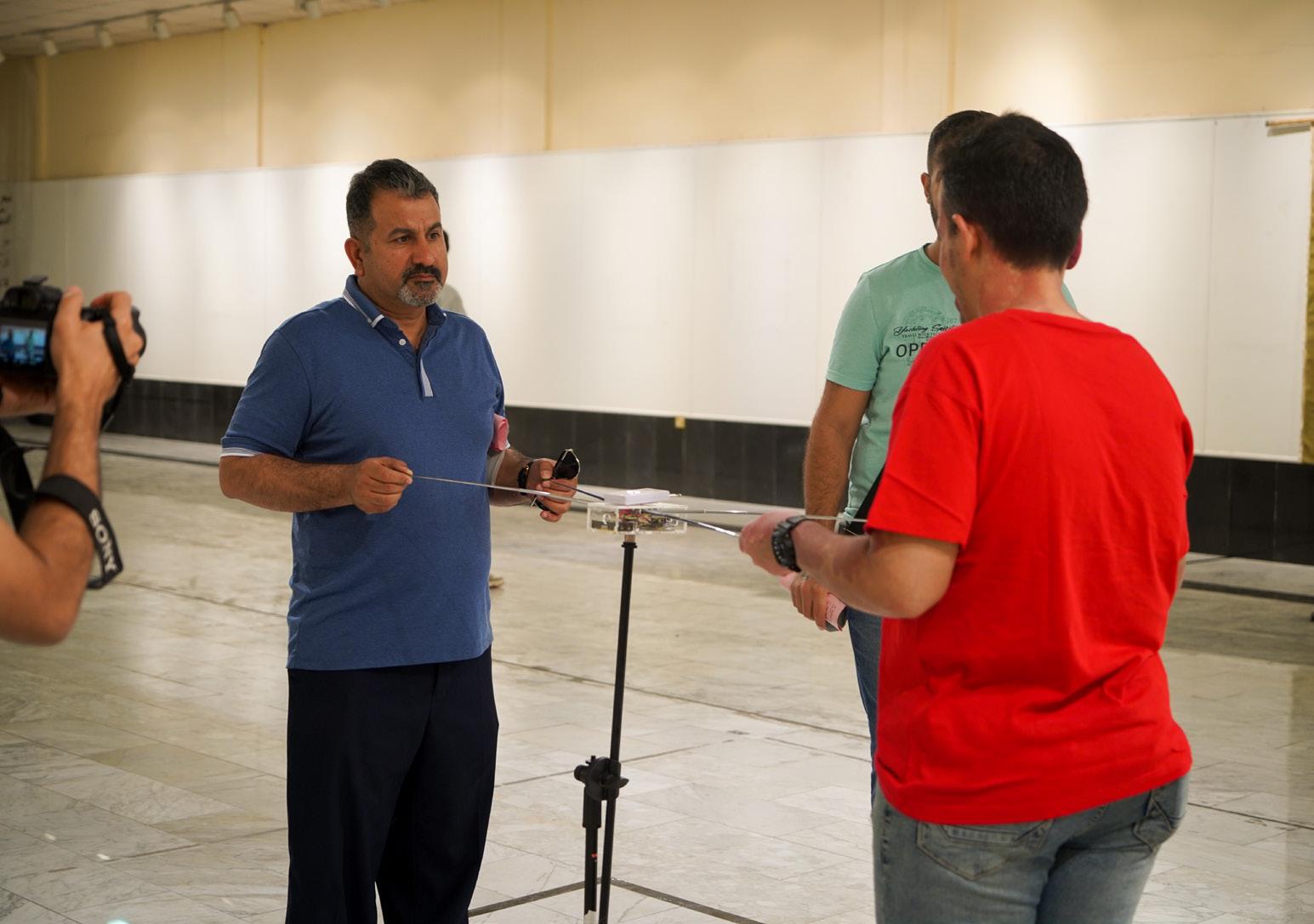
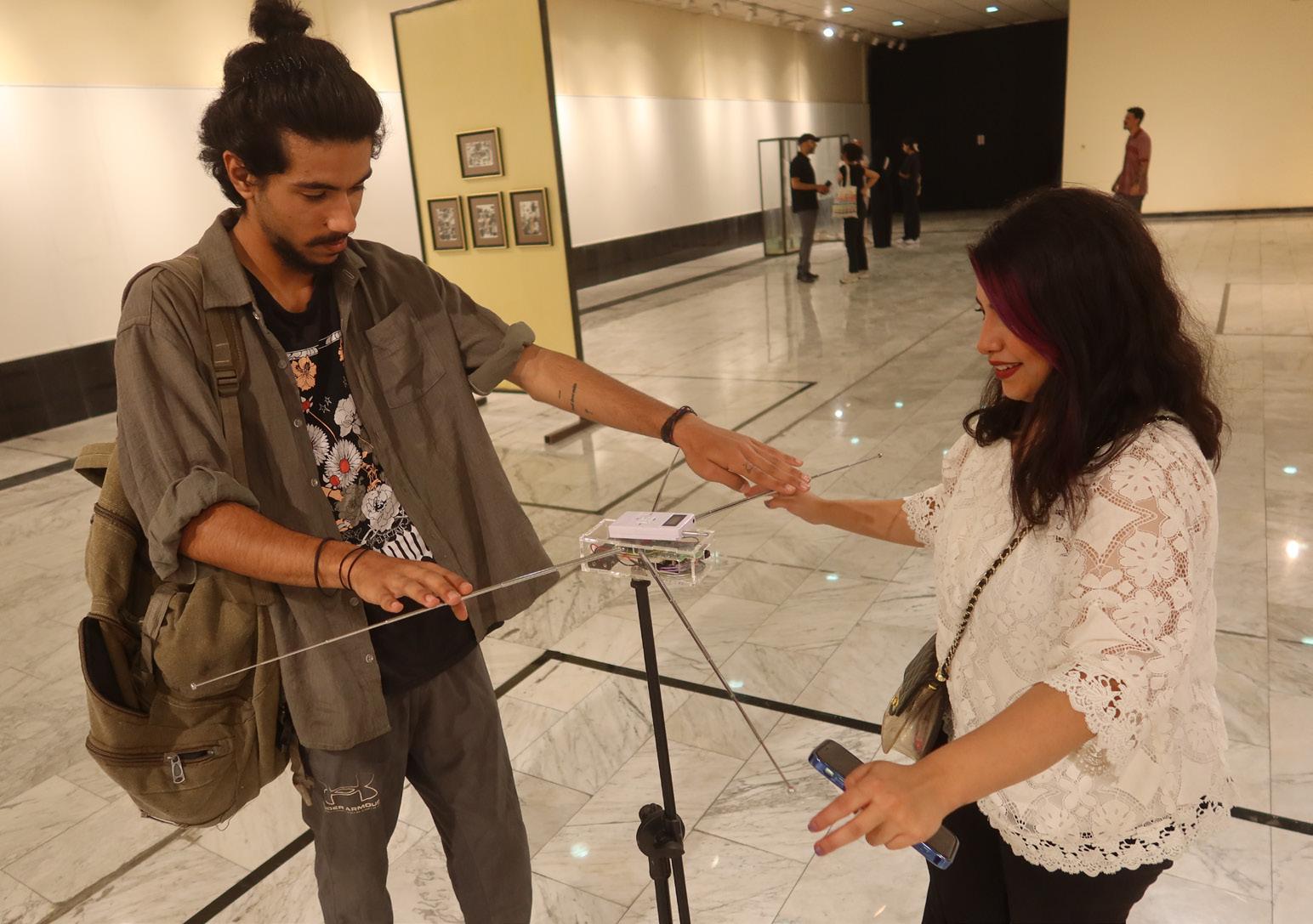



15_NŪN
Noor Abd Ali
The Arabic letter nūn can stand for feminine. Noor Abd Ali’s painting represented a selection of successful Iraqi women and their achievements in diferent felds. Her list was not intended to be exhaustive but a showcase of the variety of professional felds:
Naziha Al Dulaimi (1923-2007), the frst female Minister in modern Iraq and Middle East and the frst President of the Iraqi Women’s League; Josephine Haddad, the frst Iraqi woman to pilot an airplane in 1949; Khairya Al Mansour (b. 1958), who was the frst Iraqi woman who worked as a cinema director; Ameena Al Rahal (1915-2023), the frst Iraqi woman who worked as a lawyer and the frst woman who got a driving license; the frst female judge Sabiha Ahmed Daud (1912-1975); the doctor Saniha Amin Zaki who published the book “Memoirs of a Female Iraqi Doctor” in 2015; the paintress, author and teacher Naziha Saleem (1927-2008); the journalist and teacher Paulina Hassoun (1895-1969), the frst women who published a magazine; the poet Lamia Abbas (1929-2021); the lawyer and women rights activist Hanna Edwar (b. 1946); the paintress and former Director of the Museum of Modern Arts Layla Al Attar (1944-1993) and the Iraqi Jewish singer Salima Mourad (1900-1974).





 16_FRANKENSTEIN Alaa Adil
16_FRANKENSTEIN Alaa Adil
The fashion designer Alaa Adil conjured up her female interpretation of the character Frankenstein from recycled fabrics. She is addressing in her work the controversial Fast Fashion Industry and its negative impact on environment and humanity. Fast Fashion means mass produced clothes, a high volume in a short time, to be able to quickly response to current rapidly changing consumer trends. This in turn entails a long queue of negative impact on the environment such as land degradation and air and water pollution. The preferred use of microplastics which takes hundreds of years to biodegrade are not only toxic, but the production is an energy-intensive process that requires large amount of petroleum and others. The social impact includes forced and child labour as well as it leads consumer behaviours and demands to have more and faster trend changes.


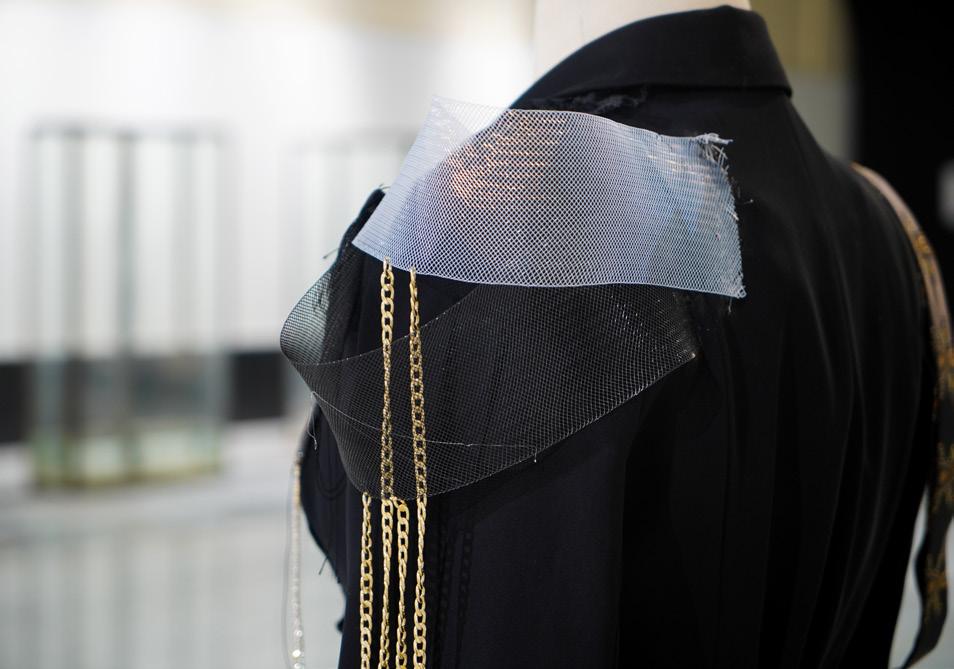

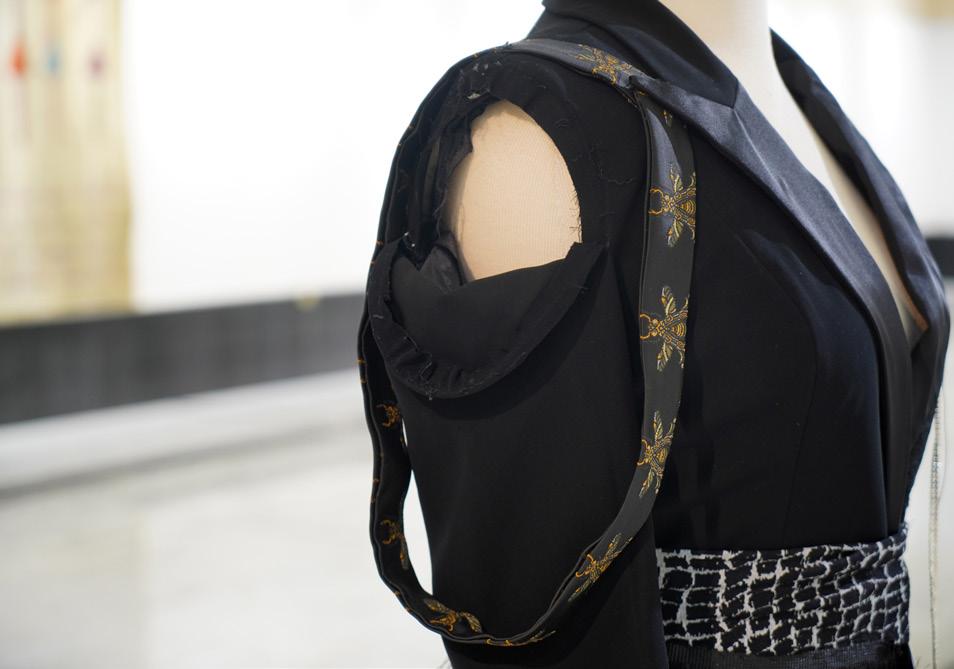
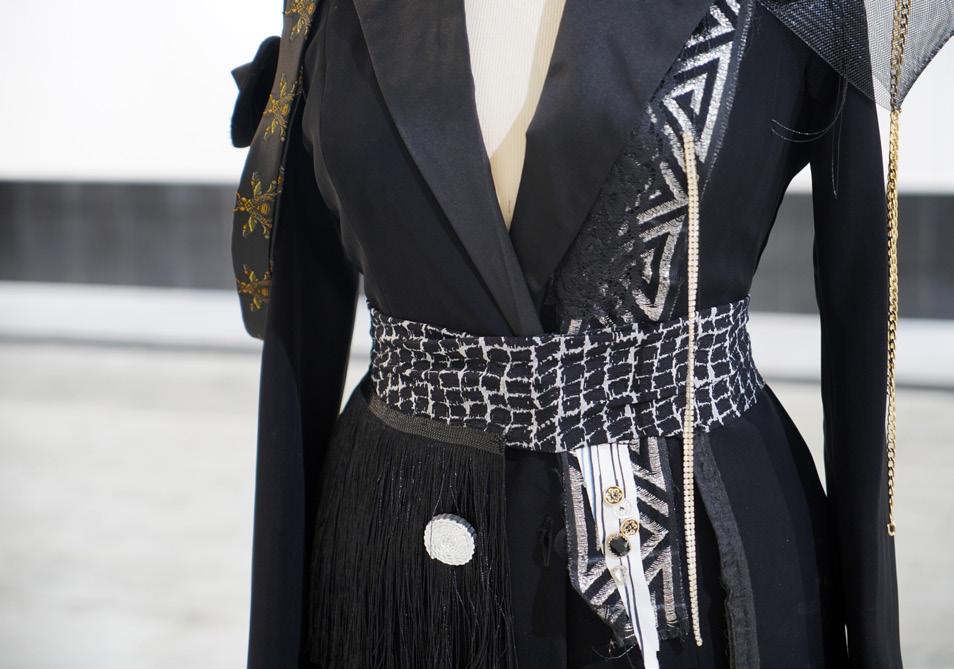



17_Shma3ia
Atef Al Jafal
The performance of Atef Al Jafal mirrored the daily life and feelings of patients in Baghdad’s forgotten madhouse Shamaeya. He created a sleeping environment behind a transparent hanging curtain with a poem written on it which he wrote from the perspective of a patient. The foil curtain let him appear inconspicuous.
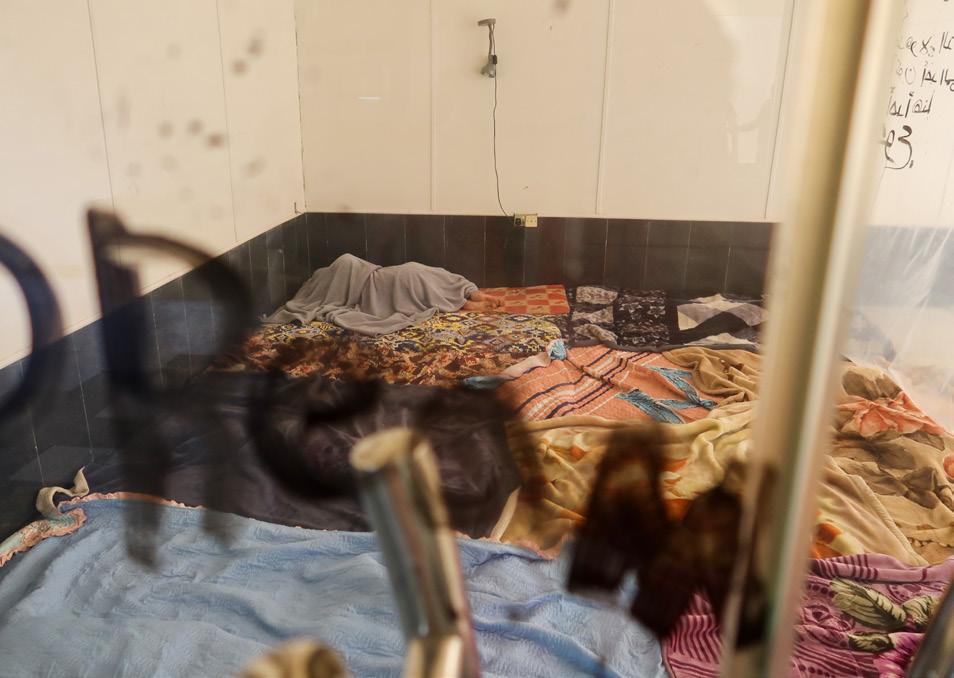




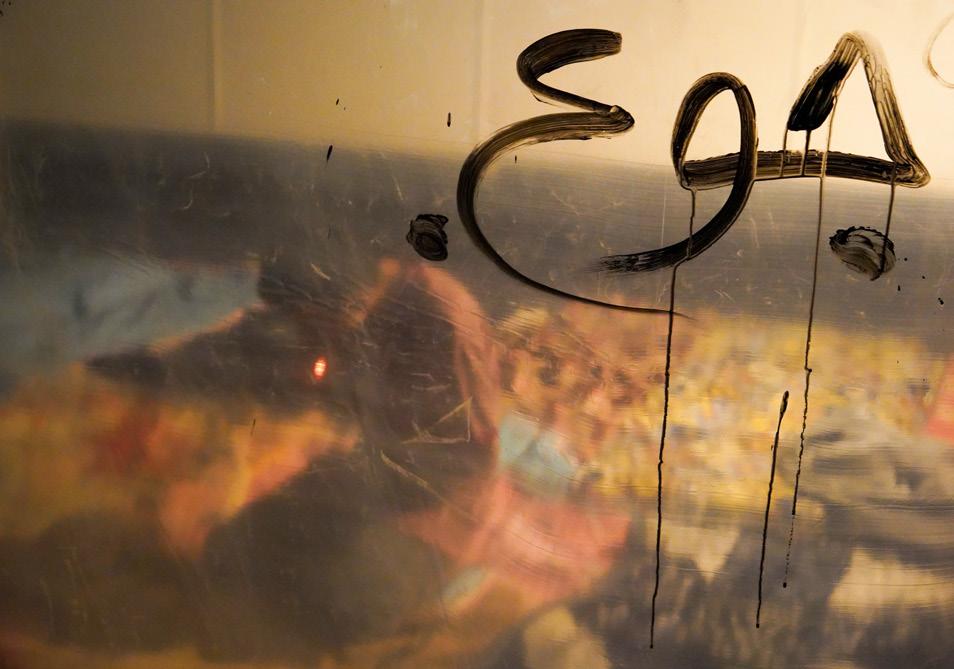

In the mornings
The screams wake us up
Or waiting kicks
Drinking the tea of yesterday
With a cigarette, I replaced it with a dream,
On the bright sunrise.
Who am I?
You ask me?... Of course, I don’t know...
I may be one of those thrown on the river side
Those whom time has forgotten maybe...
Don’t ask anyone here
The answer causes hunger
And this does not diminish us... We keep our hunger until the end of the week
Or tomorrow...
I don’t know when we last ate.
The sun is setting, I’m missing a cigarette now
And a new person arrived in our room
New until lost
The screams, will never sleep...
To wake us up in the morning.




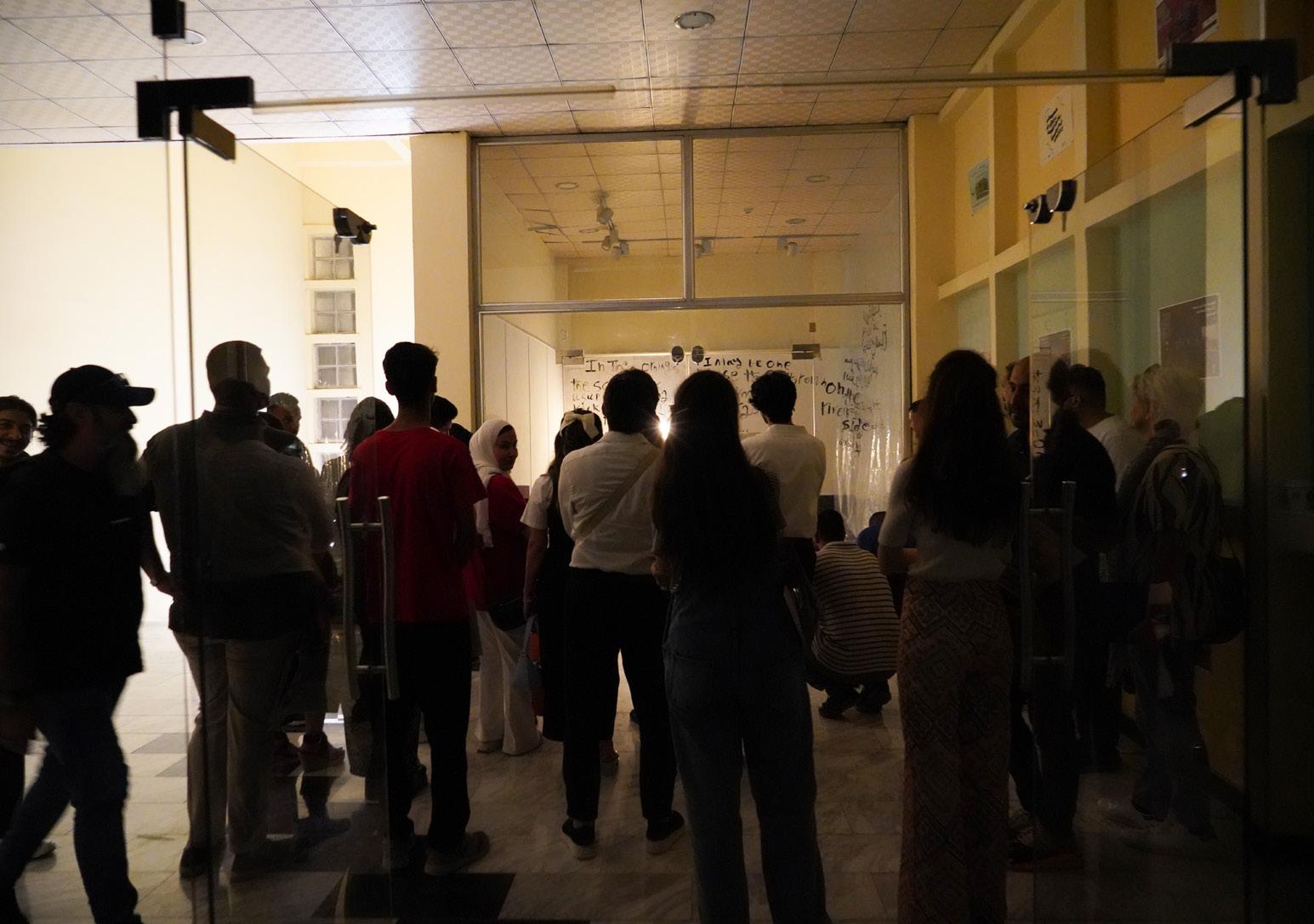



18_NEFFES
Hussam Mohammed
The two life-size glass cabinets by Hussam Mohammed pointed out the emergency of necessary steps to react to Iraq’s climate crisis. He chose lake Sawa as a ‘best practice example’. In one glass cabinet, he showed found objects he collected in the dried-up lake Sawa in 2023. In the second one he presented a pipe of a well with real water from the lake taken in 2024. His two glass cabinets have salty glass panes to refer to the cause of dehydration of the lake.
The main reason why the water of Sawa lake disappeared is the depletion of groundwater by the nearby salt extraction plant Al Samawah Saltern, nearby cement plants, in addition to the unauthorized horizontal expansion of agricultural land in the desert. Environmental oficials expect the number of wells in the desert to be around three thousand, including unlicensed drilled wells.
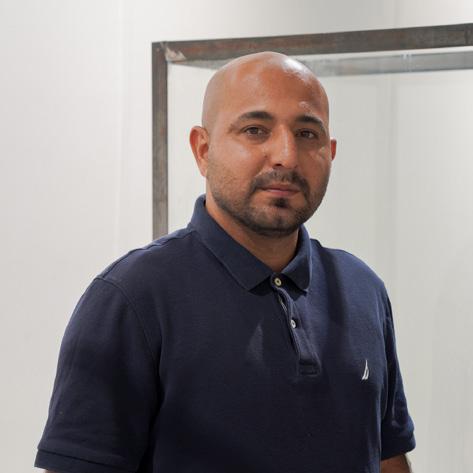
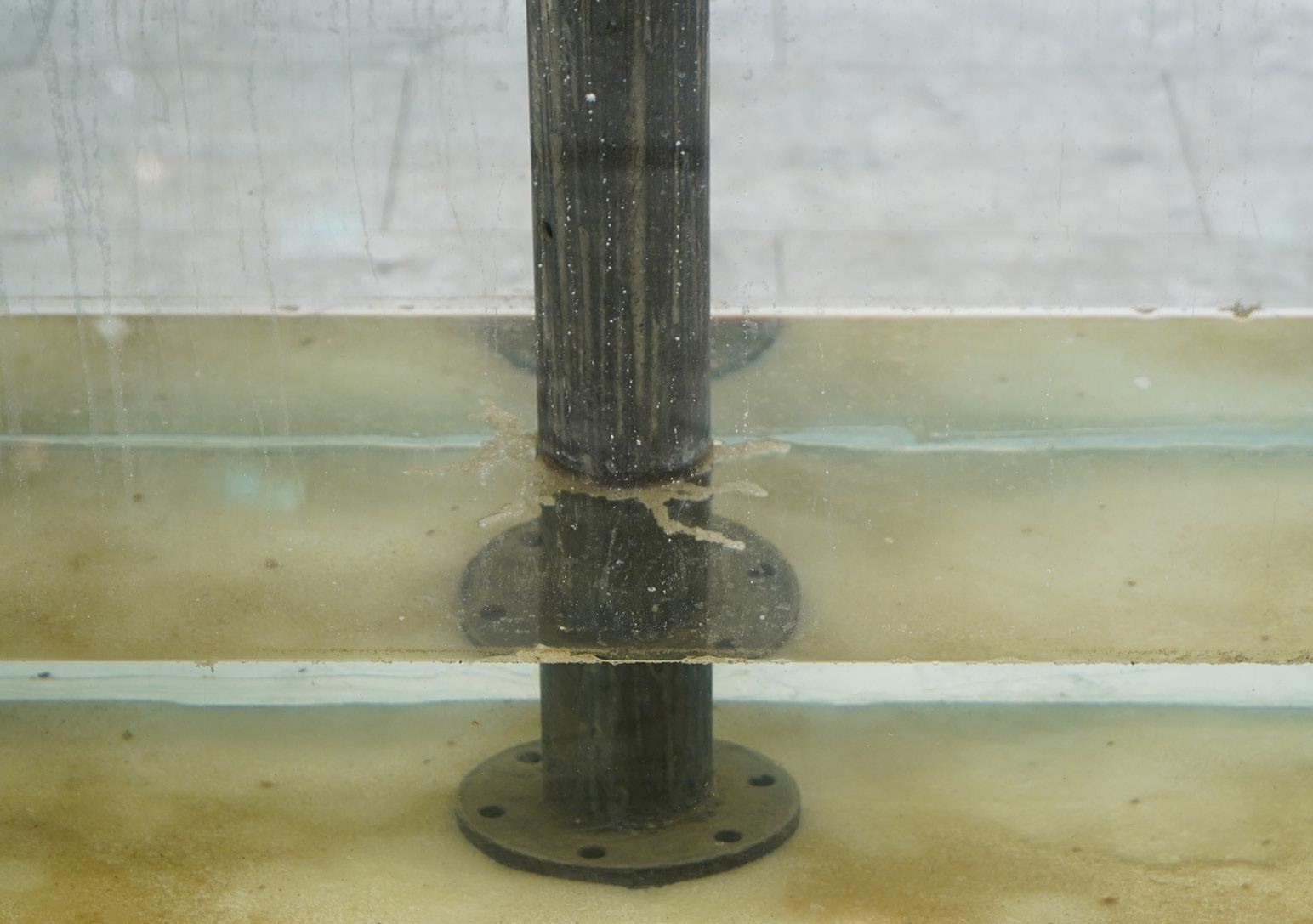





The architectural student Aishe Shabeeb presented a light installation showing an acrylic glass cube engraved with nouns that express feelings and emotions and how these words can form a person. The words were projected as light shadows on ceiling and walls.
For Aishe, the cube represents the world we live in, while the words represent the thoughts and feelings that shape our experiences. Light symbolizes knowledge and understanding, while shadows represent the unknown and hidden aspects of life.
The interplay of light and shadow creates a feeling of movement and dynamism, refecting the ever-changing nature of life. It also highlights the contradictions that exist in the world, such as good and evil, beauty and ugliness, love and hate.
The work invites us to refect on the nature of life and our relationship with the world around us. It reminds us that life is full of contradictions, and that knowledge and understanding are the keys to understanding life.
19_ THE DANCE OF LIGHT AND SHADOW Aishe Shabeeb
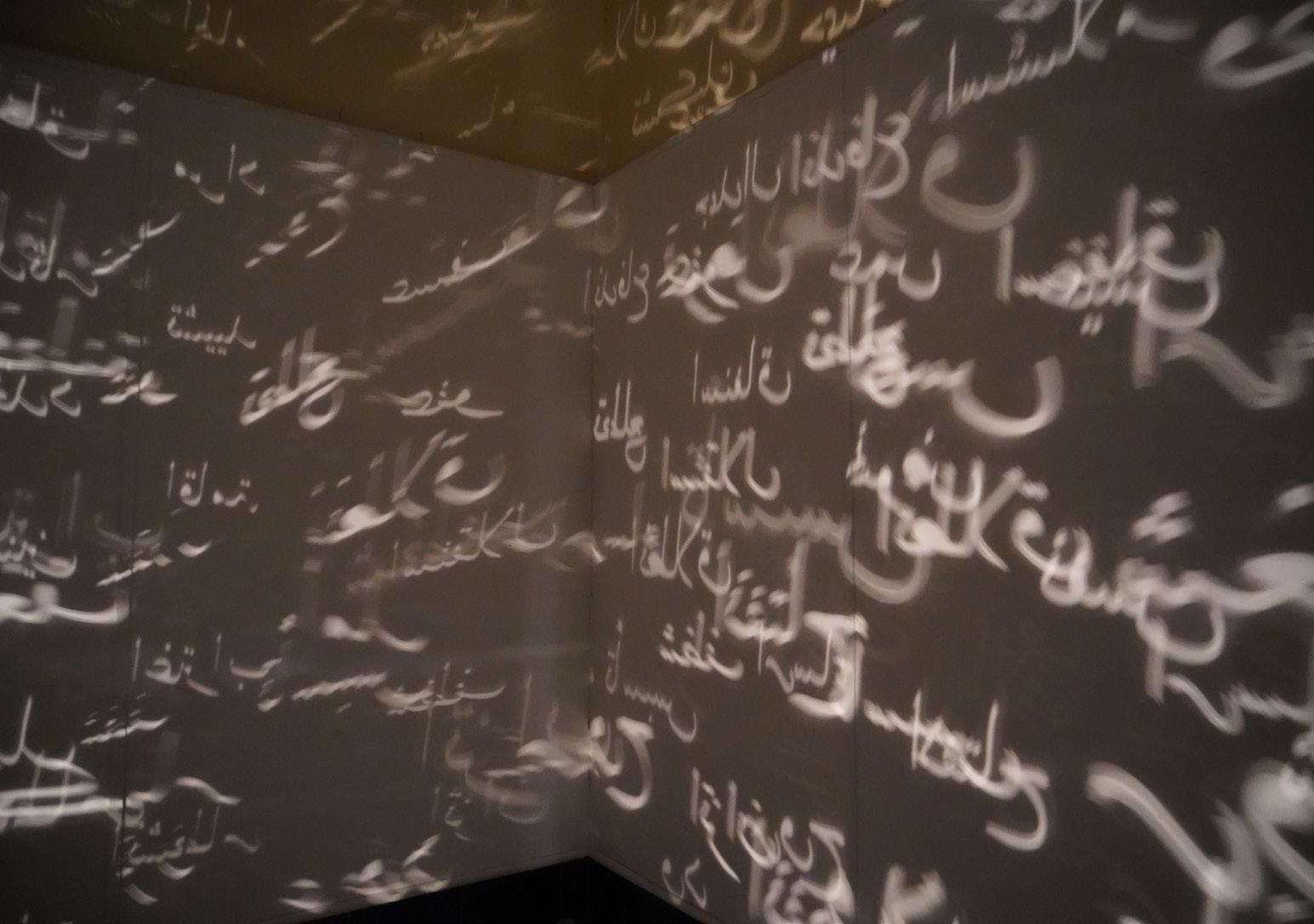
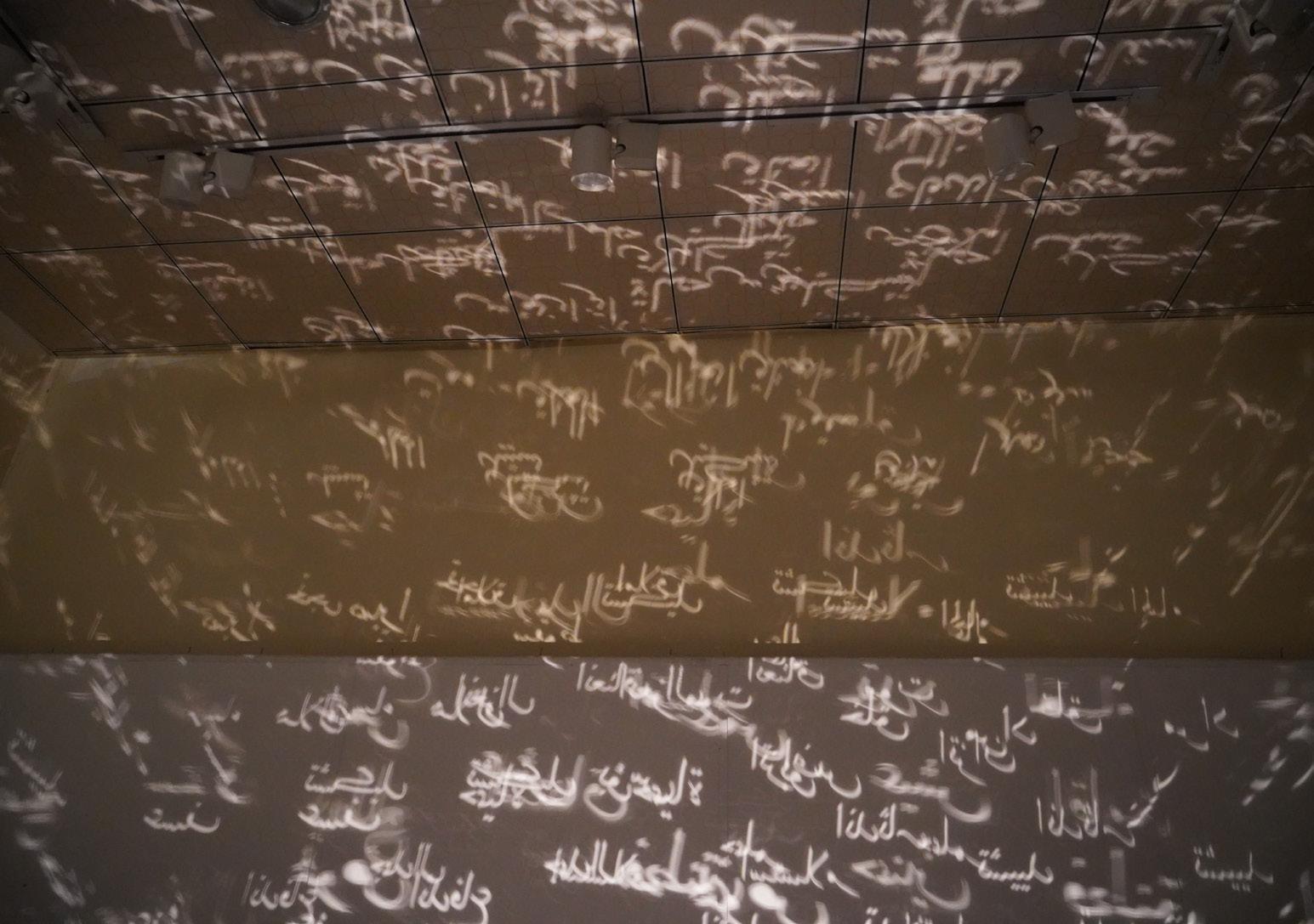




20_NCV=0
Maees Hadi
NCV is a code American uses to estimate possible human victims in a military attack. For Maees Hadi, the forecast should be zero. The video she presented shows scenes of conversations with her sister and mother from the perspective of a forced child generation who had to leave Iraq in the 1990s. We see her childhood memories in Europe paired with shootings in a self-built maquette house symbolizing the stay-behind home in Iraq. The video included a verbose boot of Iraqi war victims.




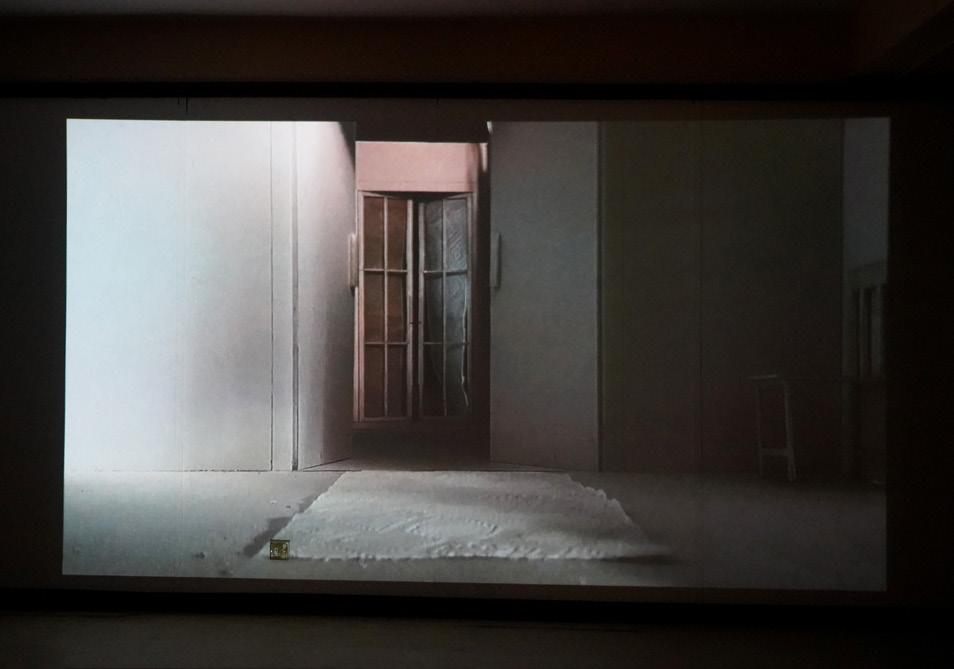




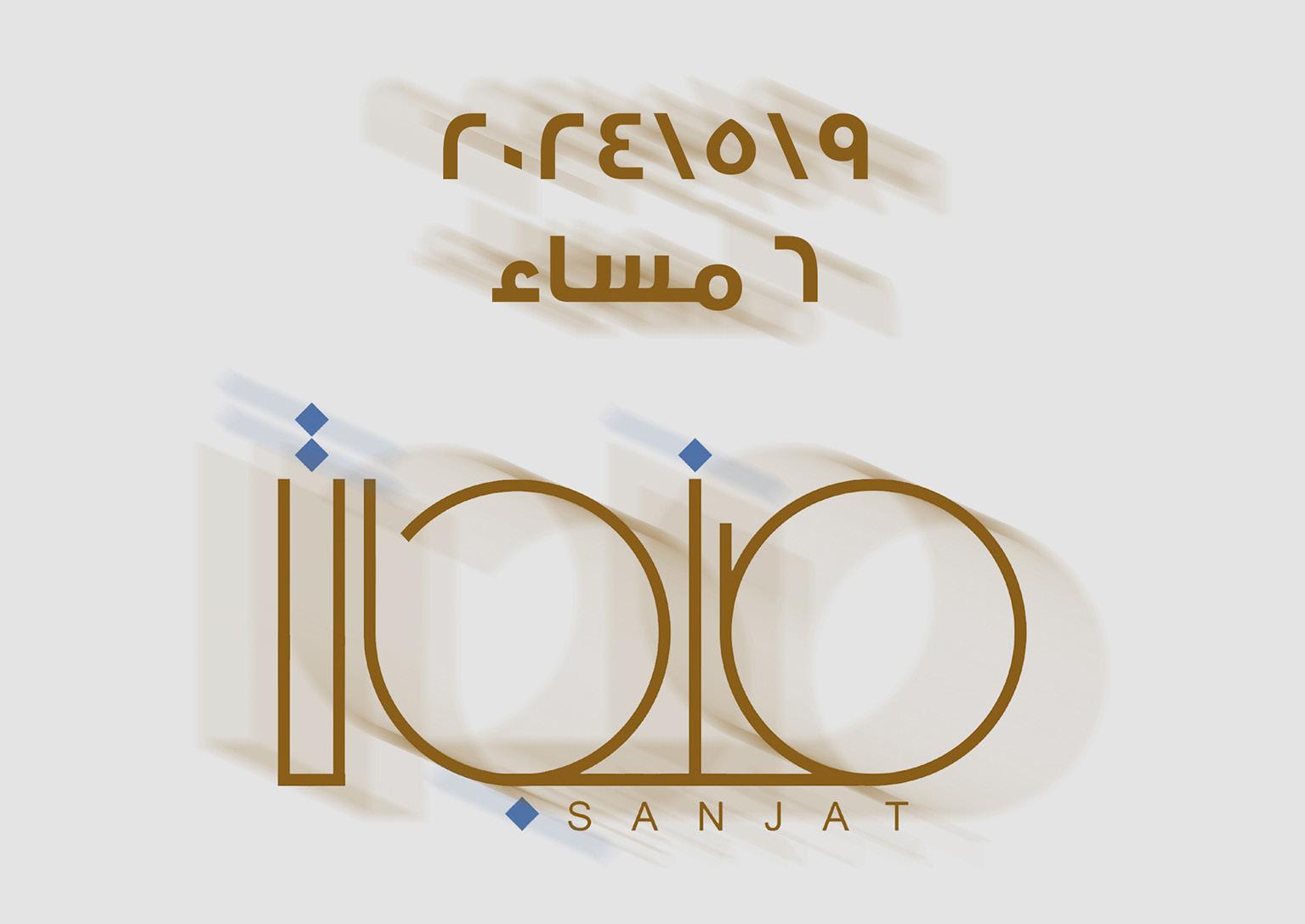

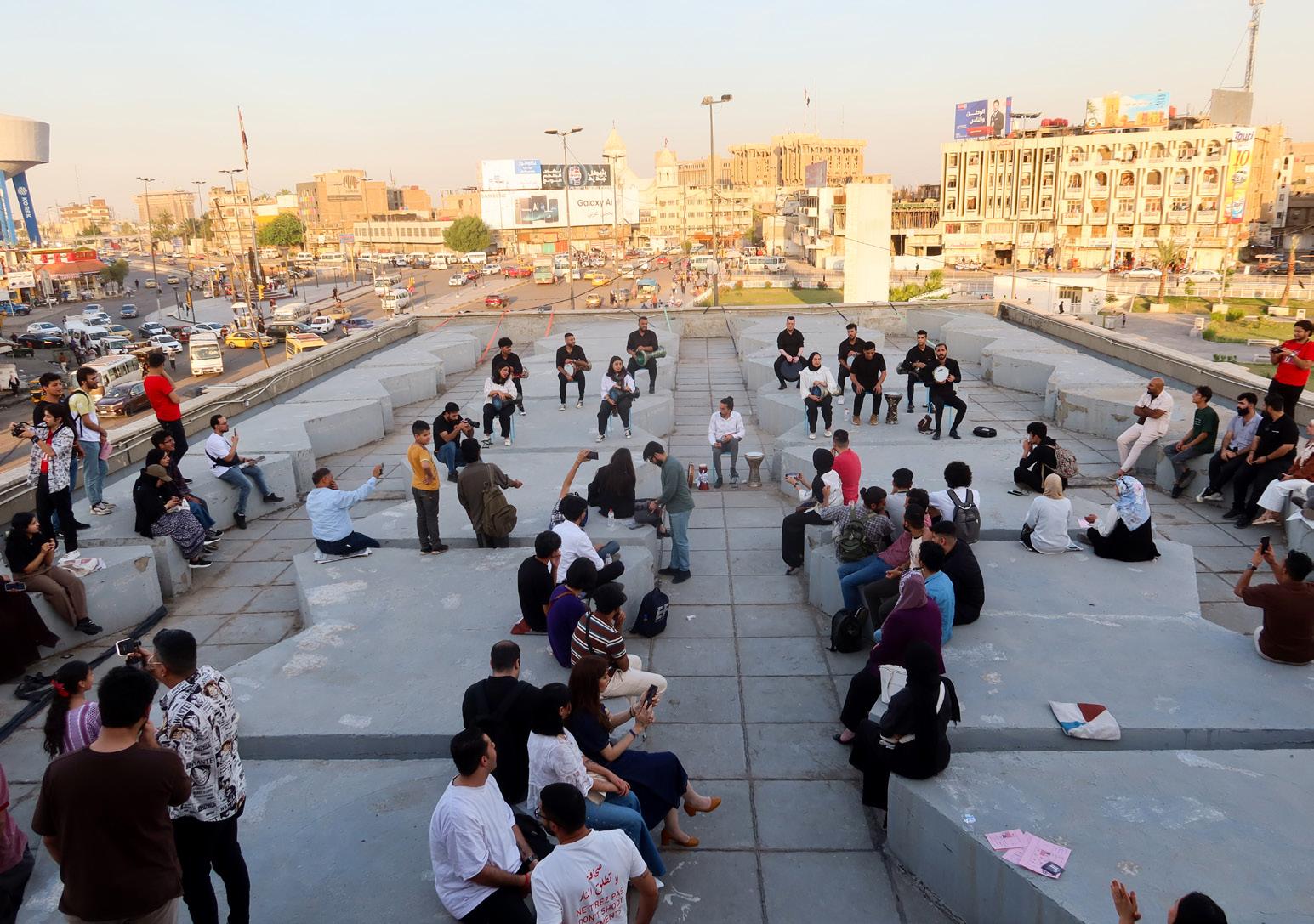

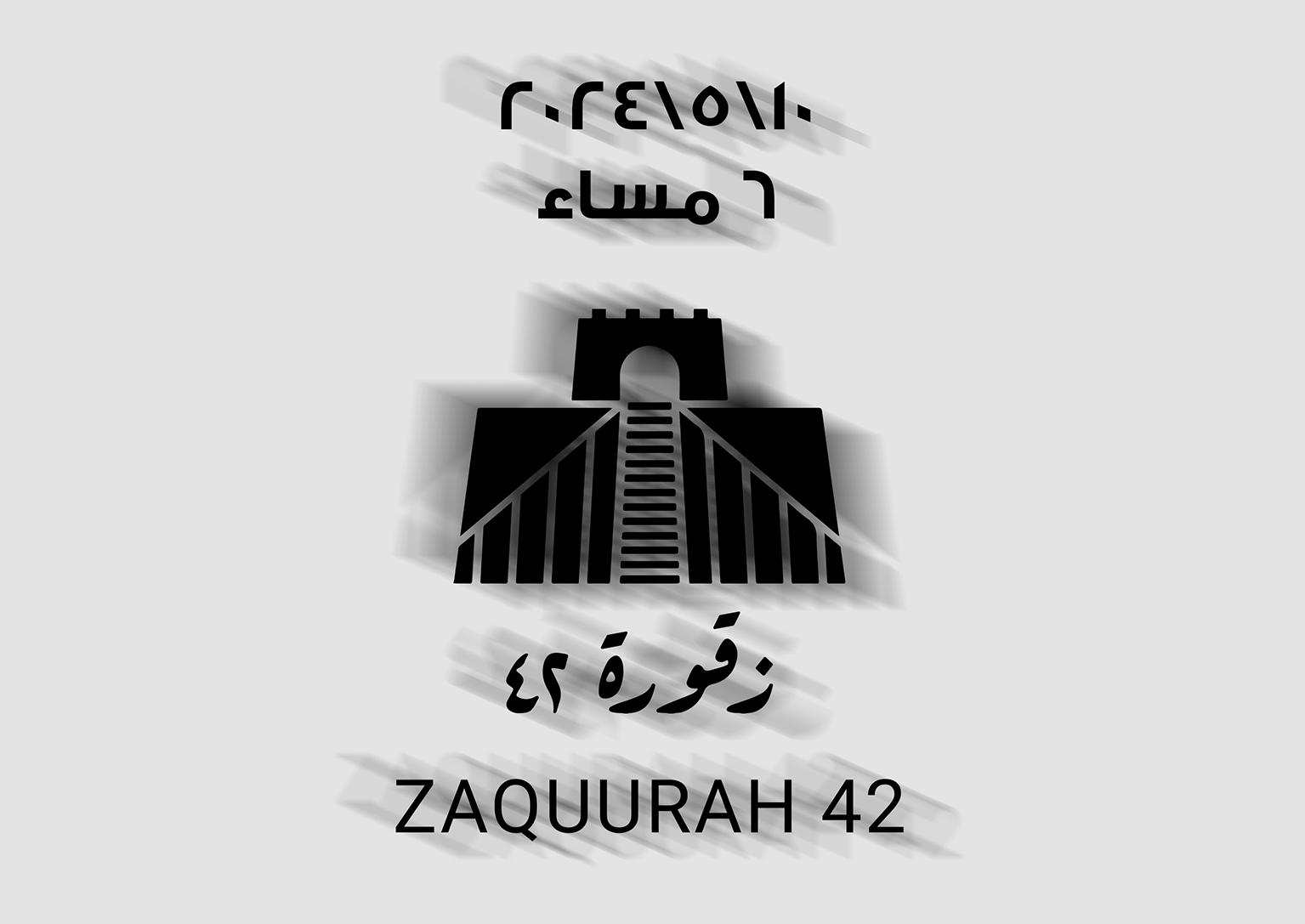




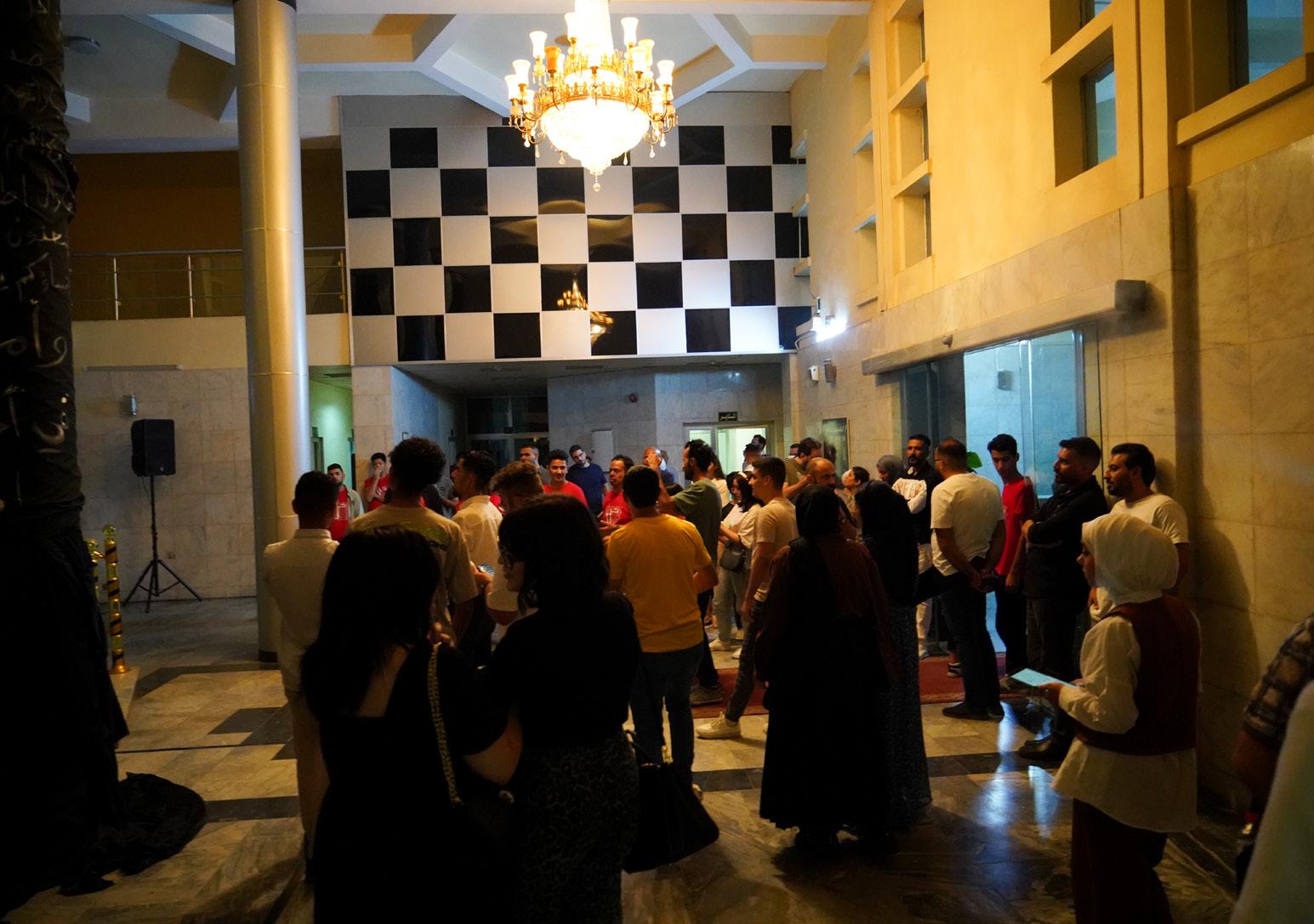

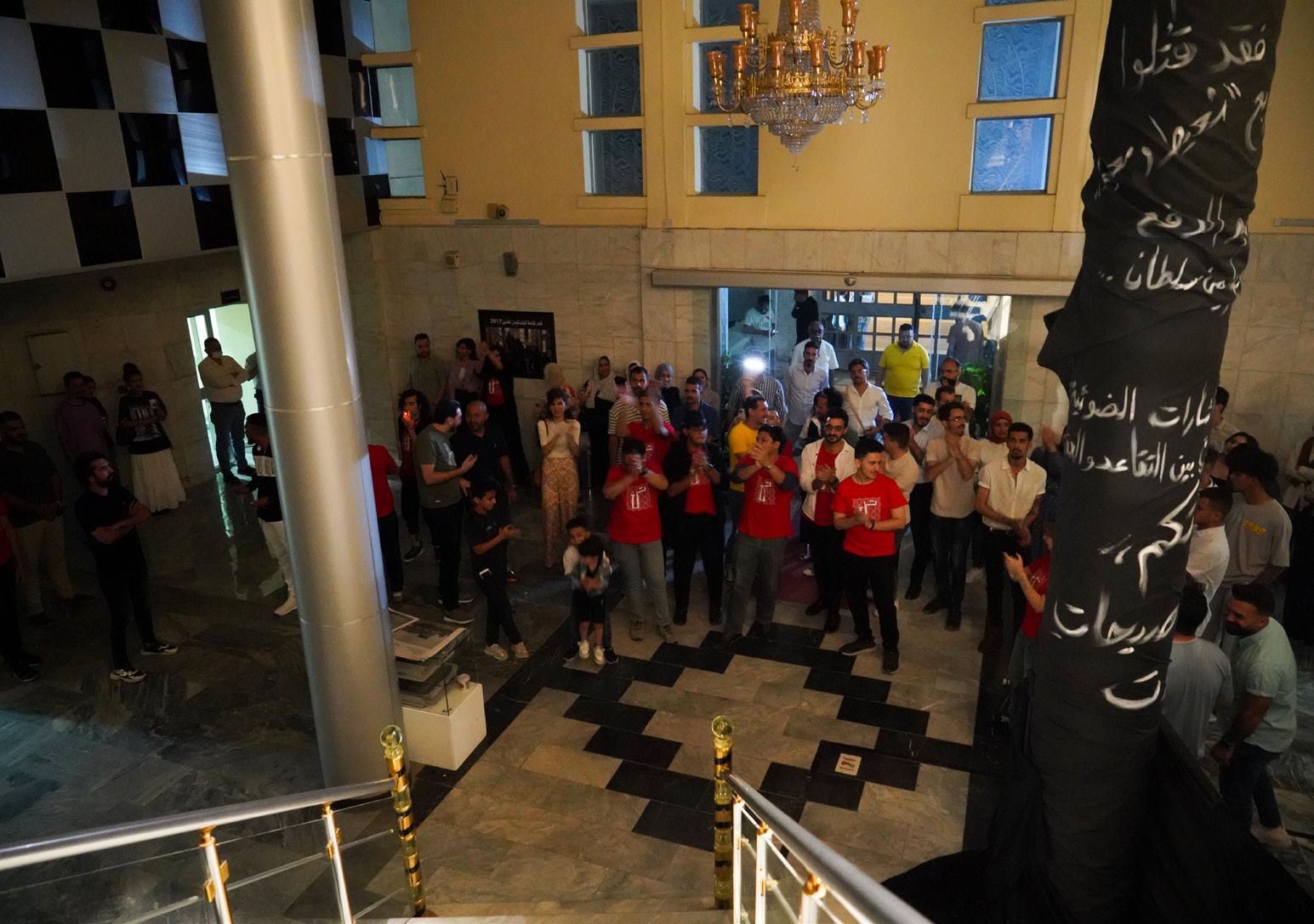
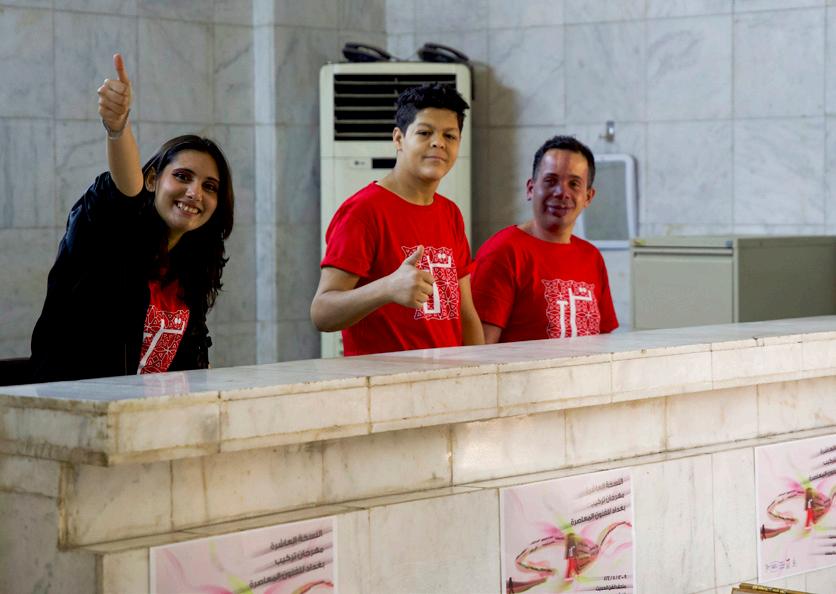
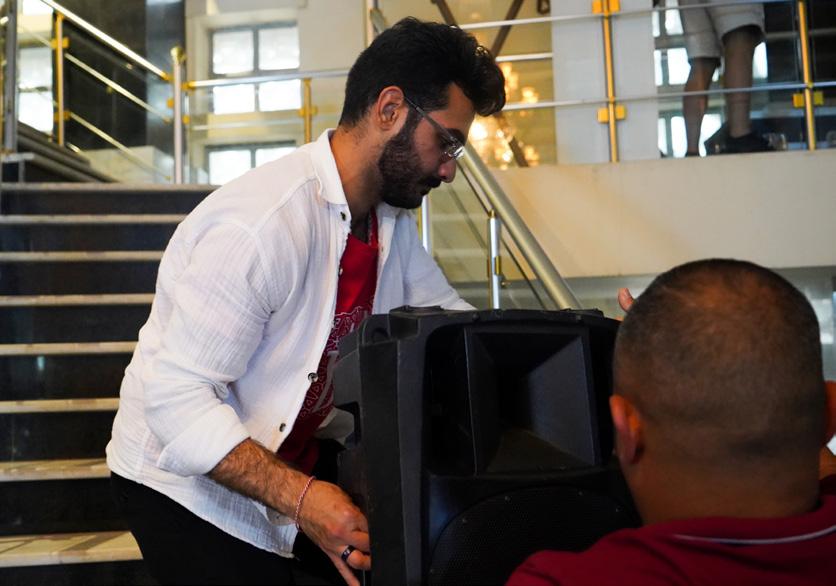


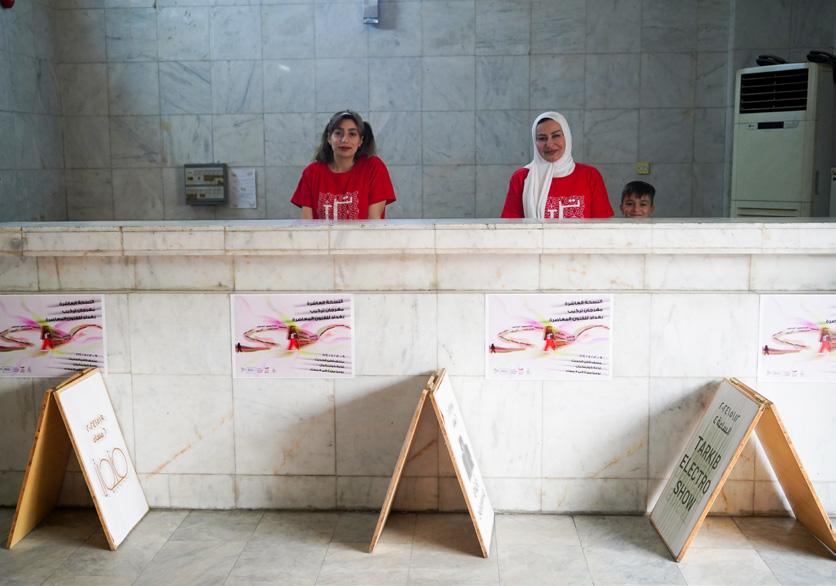



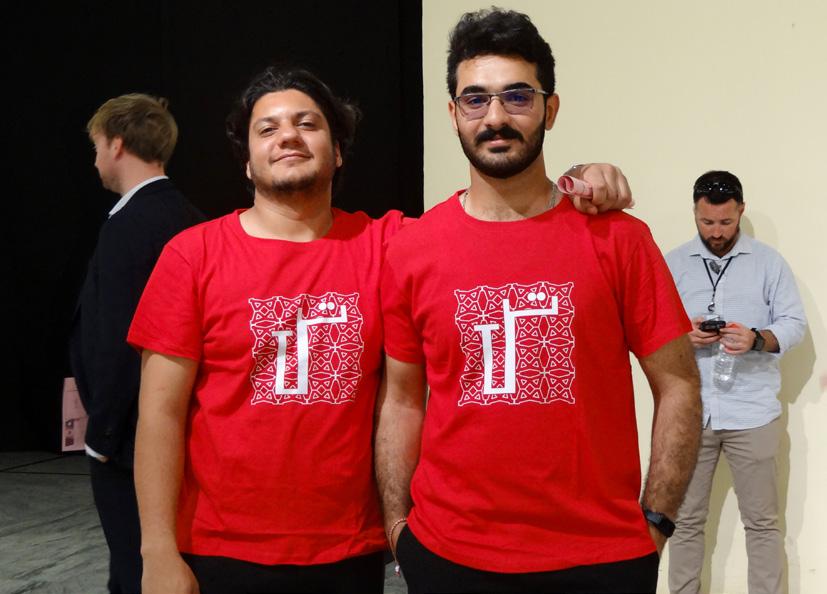



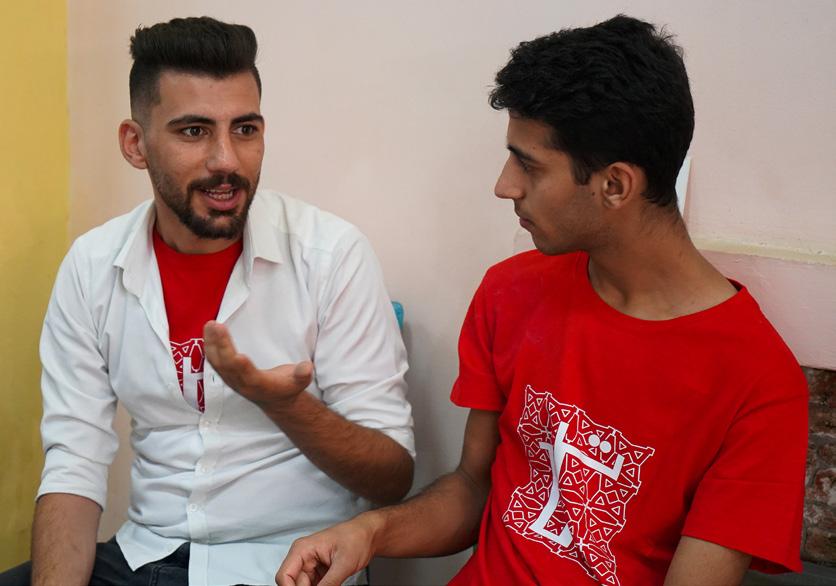


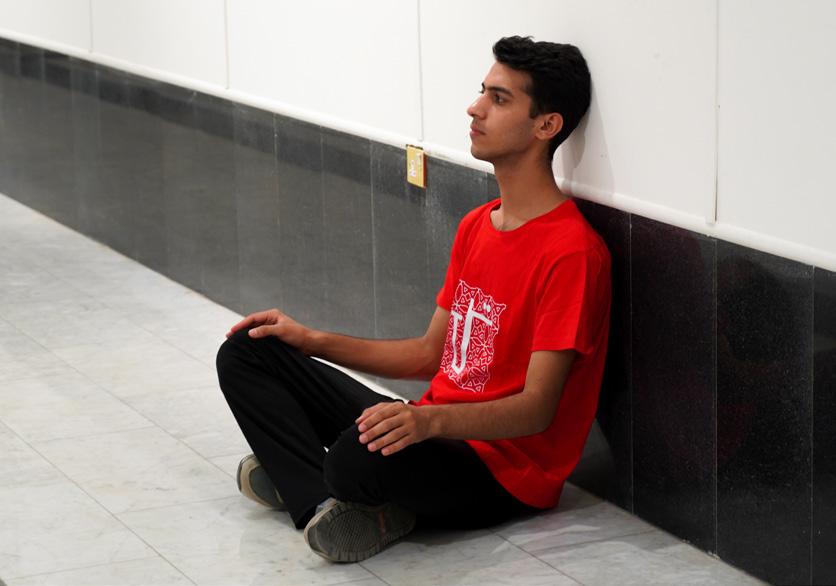
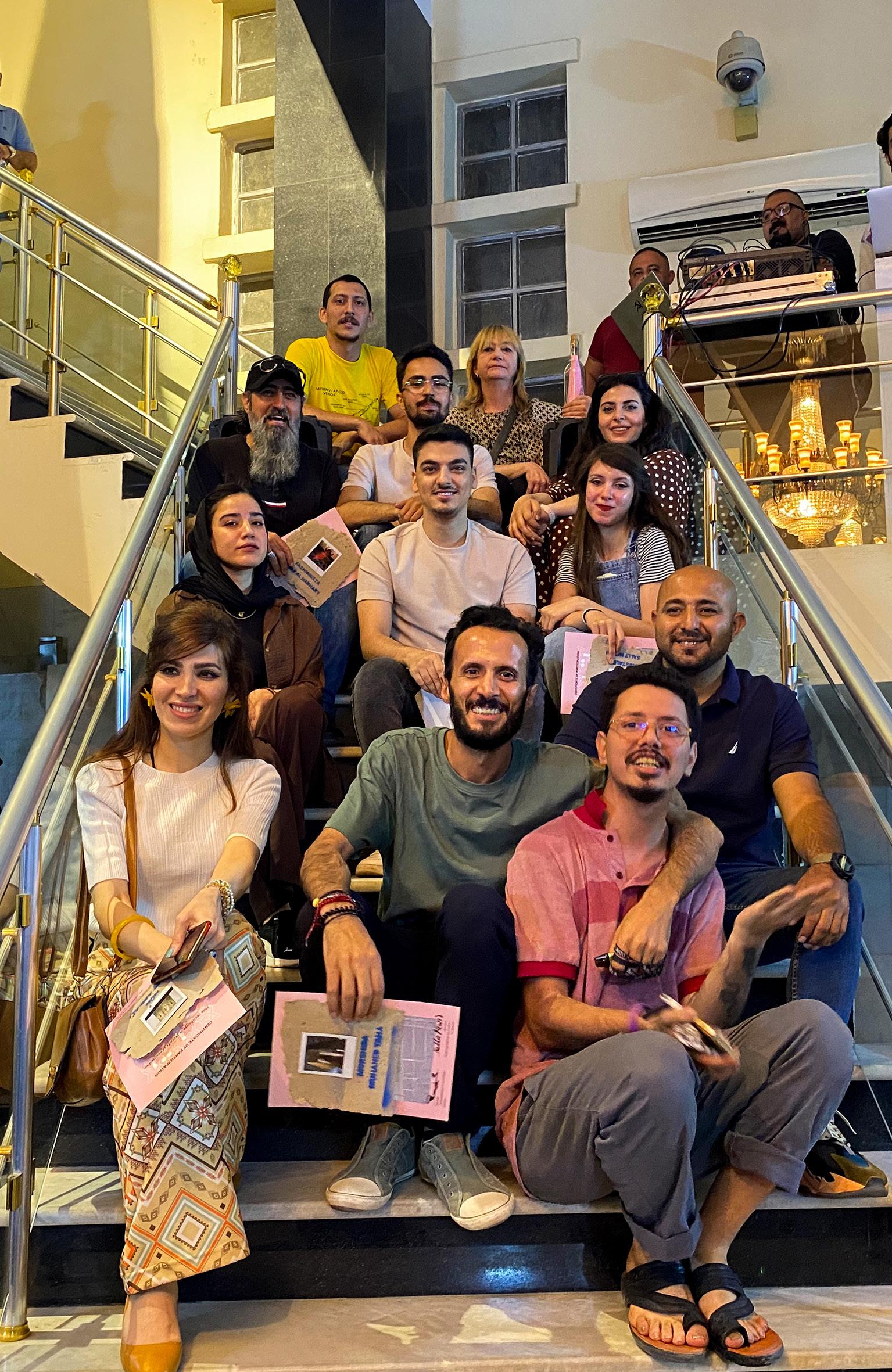
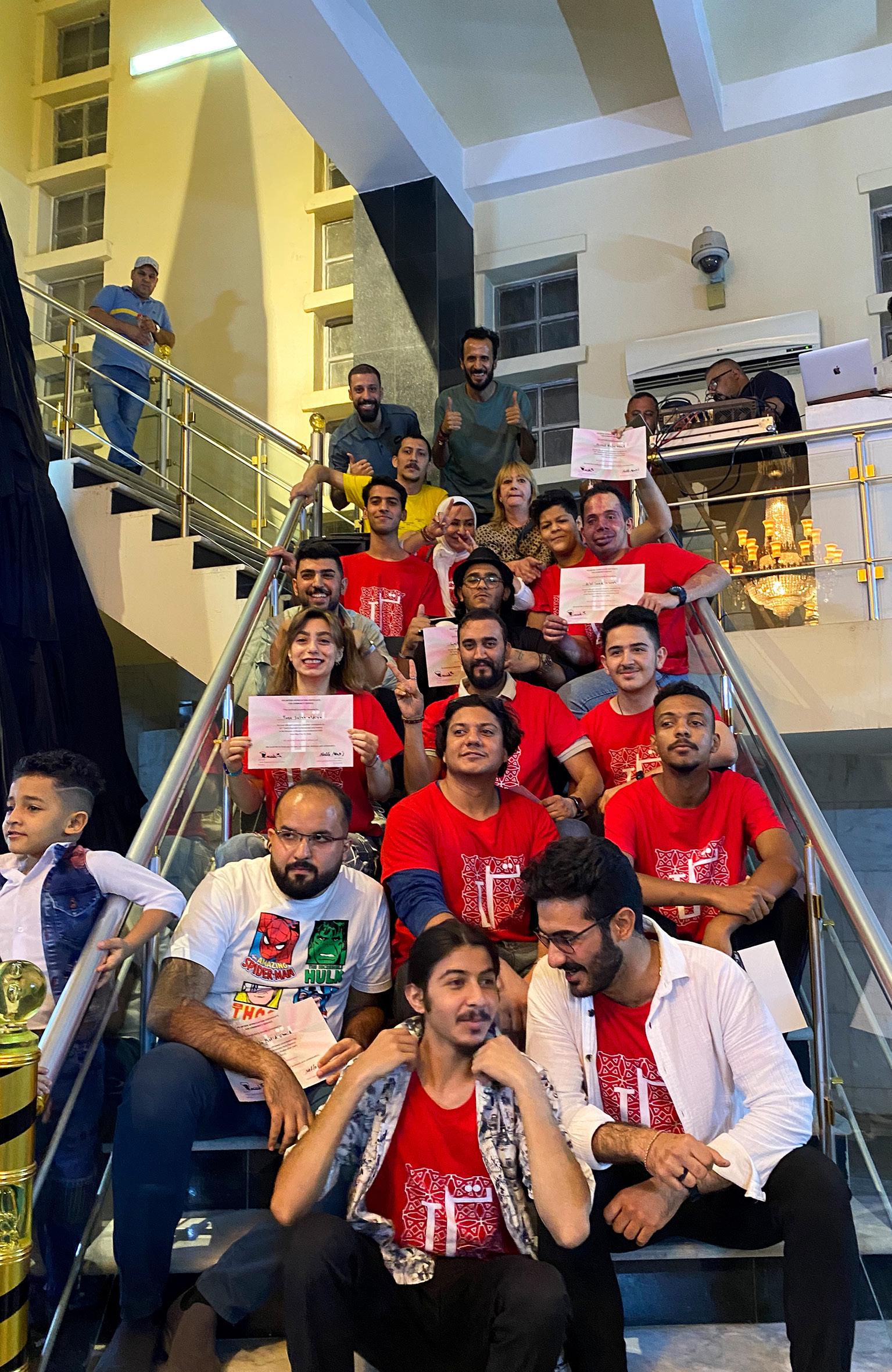




Imprint
This booklet is published on the occasion of 10.th Tarkib Baghdad Contemporary Arts Festival which took place from May 9 to 12, 2024 in the Museum of Modern Arts (Gulbenkian Hall).
www.tarkib.net
This year’s edition is a cooperation with the French Institute in Baghdad and the French Embassy in Iraq and it could make possible through a program grant by TotalEnergies in Iraq to support young Iraqi talents.
Design: ART TC (Hella Mewis and Atef Al Jafal)
Photos: Hella Mewis, Mounir Salah
Text: Hella Mewis
© Tarkib Organization for Arts & Culture
All rights reserved.
